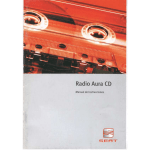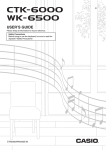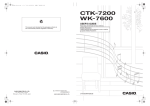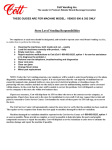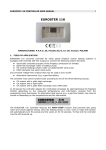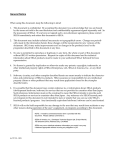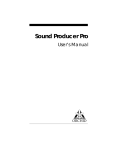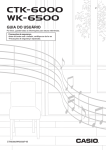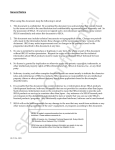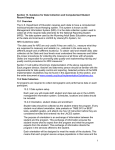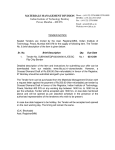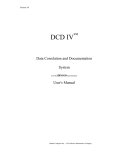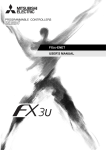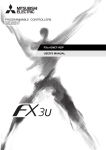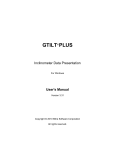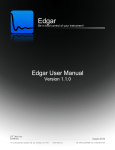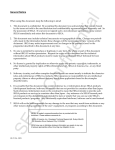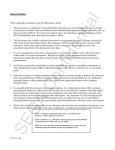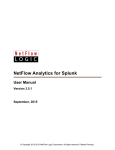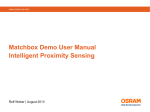Download System Library User`s Manual
Transcript
When using this document, keep the following in mind: nti al General Notice 1. This document is confidential. By accepting this document you acknowledge that you are bound by the terms set forth in the non-disclosure and confidentiality agreement signed separately and /in the possession of SEGA. If you have not signed such a non-disclosure agreement, please contact SEGA immediately and return this document to SEGA. de 2. This document may include technical inaccuracies or typographical errors. Changes are periodically made to the information herein; these changes will be incorporated in new versions of the document. SEGA may make improvements and/or changes in the product(s) and/or the program(s) described in this document at any time. nfi 3. No one is permitted to reproduce or duplicate, in any form, the whole or part of this document without SEGA’S written permission. Request for copies of this document and for technical information about SEGA products must be made to your authorized SEGA Technical Services representative. Co 4. No license is granted by implication or otherwise under any patents, copyrights, trademarks, or other intellectual property rights of SEGA Enterprises, Ltd., SEGA of America, Inc., or any third party. 5. Software, circuitry, and other examples described herein are meant merely to indicate the characteristics and performance of SEGA’s products. SEGA assumes no responsibility for any intellectual property claims or other problems that may result from applications based on the examples describe herein. GA 6. It is possible that this document may contain reference to, or information about, SEGA products (development hardware/software) or services that are not provided in countries other than Japan. Such references/information must not be construed to mean that SEGA intends to provide such SEGA products or services in countries other than Japan. Any reference of a SEGA licensed product/program in this document is not intended to state or simply that you can use only SEGA’s licensed products/programs. Any functionally equivalent hardware/software can be used instead. 7. SEGA will not be held responsible for any damage to the user that may result from accidents or any other reasons during operation of the user’s equipment, or programs according to this document. SE NOTE: A reader's comment/correction form is provided with this document. Please address comments to : (6/27/95- 002) SEGA of America, Inc., Developer Technical Support (att. Evelyn Merritt) 150 Shoreline Drive, Redwood City, CA 94065 SEGA may use or distribute whatever information you supply in any way it believes appropriate without incurring any obligation to you. SE GA Co nfi de nti al TM System Library User's Guide Doc. # ST-162-062094 CONTENTS System Program User’s Manual .......................... 1 SMPC I/F User’s Manual ..................................... 7 CD Communication Interface User’s Manual ..... 21 © 1994 SEGA. All Rights Reserved. nti al READER CORRECTION/COMMENT SHEET Keep us updated! If you should come across any incorrect or outdated information while reading through the attached document, or come up with any questions or comments, please let us know so that we can make the required changes in subsequent revisions. Simply fill out all information below and return this form to the Developer Technical Support Manager at the address below. Please make more copies of this form if more space is needed. Thank you. General Information: Phone Document number Document name Date ST-162-062094 System Library User's Guide Corrections: Correction nfi pg. # GA Co Chpt. de Your Name SE Questions/comments: Fax: Where to send your corrections: (415) 802-3963 Attn: Manager, Developer Technical Support Mail: SEGA OF AMERICA Attn: Manager, Developer Technical Support 275 Shoreline Dr. Ste 500 Redwood City, CA 94065 nti al REFERENCES KenKyusha New Japanese-English Dictionary 1974 Edition 2. Nelson’s Japanese-English Character Dictionary 2nd revised version 3. Microsoft Computer Dictionary 4. Japanese-English Computer Terms Dictionary Nichigai Associates 4th version SE GA Co nfi 1. de In translating/creating this document, certain technical words and/or phrases were interpreted with the assistance of the technical literature listed below. SE GA Co nfi de nti al (This page is blank in the original Japanese document.) ii nti al Table of Contents SYSTEM PROGRAM USER’S MANUAL ............................................. 1 1.0 GUIDE .............................................................................................. 1 1.1 Explanation ............................................................................ 1 2.0 REFERENCE .................................................................................... 3 2.1 List of Functions .................................................................... 3 2.2 Function Specifications ......................................................... 3 de SMPC I/F USER’S MANUAL ................................................................. 7 GUIDE .............................................................................................. 7 1.1 Objective ................................................................................. 7 1.2 Overview ................................................................................ 7 1.3 System Management System ............................................... 7 1.4 Peripheral Control System ................................................... 8 2.0 REFERENCE .................................................................................. 11 2.1 Data Specification List ........................................................ 11 2.2 Data Specifications .............................................................. 11 2.3 List of Function Specifications .......................................... 15 2.4 Function Specifications ....................................................... 16 nfi 1.0 Co CD COMMUNICATION INTERFACE USER’S MANUAL ............. 21 OVERVIEW .................................................................................... 21 1.1 Library Configuration ........................................................ 21 1.2 System Configuration ......................................................... 22 1.3 Functions and Characteristics ........................................... 23 2.0 BASIC FACTS ................................................................................ 24 2.1 Terminology and Symbols ................................................. 24 2.2 Disk Layout .......................................................................... 26 3.0 COMMUNICATION WITH THE CD BLOCK ......................... 27 3.1 Communication Register ................................................... 27 3.2 Communication Method .................................................... 29 3.3 Response ............................................................................... 31 3.4 Data Transfer ........................................................................ 32 SE GA 1.0 iii CD DRIVE ......................................................................... 33 4.1 CD Drive Status Change ....................................... 33 4.2 CD Drive Operation ............................................... 37 4.3 Subcodes .................................................................. 39 5.0 CD BLOCK CONFIGURATION .................................... 41 5.1 Data Flow ................................................................ 41 5.2 Stream Process Mechanism................................... 42 5.3 Selector Configuration........................................... 43 5.4 Sector Data Format................................................. 48 5.5 CD Block Initialization .......................................... 49 6.0 CD BLOCK FILE SYSTEM .............................................. 50 6.1 File Management in CD-ROM (ISO9660) ........... 50 6.2 CD Block File System Functions .......................... 51 7.0 DATA SPECIFICATIONS................................................ 55 7.1 Data List................................................................... 55 7.2 Data Detailed .......................................................... 56 8.0 FUNCTION SPECIFICATIONS ..................................... 73 8.1 List of Functions ..................................................... 74 8.2 Function Details...................................................... 76 nfi de nti al 4.0 SE GA Co Index .......................................................................................... 104 iv nti al Pages 1-20 of this document have been de archived. The revised pages of the “System Program User’s Manual” and nfi the “SMPC I/F User’s Manual” can be Co found in ST-162-R1-092994 entitled “SATURN System Library User’s SE GA Guide ver.1.0”. nti al CD Communication Interface User’s Manual 1.0 OVERVIEW This document is a collection of CD block functions and CD communication interface external specifications. Functions of CD blocks are classified in Table 1.1 below. Table 1.1 Classification of CD Block Functions Classification Communication format, CD drive related, CD buffer related de CD Part Description CD block file system related MPEG Part MPEG Related 1.1 Library Configuration nfi CD block functions can be used by a common software interface through the CD communication interface. The library configuration of CD relationships is shown in Figure 1.1. Co Application Branch Animation Play Library MPEG Library (MPG) File System Library (GFS) CD Communication Interface (CDC) GA Software Stream System Library (STM) ................................................................................ Hardware CD Block SIMM, SCSI SE Figure 1.1 Library Structure of CD Relationships System Library User's Guide 21 1.2 System Configuration Host Program (File system, Application, etc.) H OST Return CD Communication Interface Command Response Fetch data Write data nfi Communication with CD Block (DMA, etc., Data Transfer Module) de Function Call nti al The system configuration of CD relationships is shown in Figure 1.2. [Command Input/Output Register] [Data Transfer Register] Co CD Block Program (Host Communication Interface, BIOS, etc.) Communication with CD Drive CD Drive C D B L O CK Hardware Interface GA In interfacing with the CD block, the main system is called the host. Moreover, The CD block is one subsystem. Figure 1.2 System Structure of CD Relationships 1) Communication with the CD Block The host and CD block communicate (command/response, data transfer) using registers on the hardware interface. A command issued from the host to the CD block is called a CD block command; however, this is normally shortened to command. SE 2) CD Drive The CD block periodically communicates with the CD drive controlling the CD drive with respect to commands from the host. The CD drive accommodates the CD-ROM XA standard and multi-session. It is able to switch between the standard speed as well as double the standard speed. (Standard speed is automatically set when playing CD-DA.) 22 1.3 Functions and Characteristics nti al Numbers “1” to “3” below are functions of the CD communication interface, and “4” to “7” are CD block functions. 1. CD Block Communication Functions (a) Communicates between the host and CD block and is the C Language interface function set. (b) Issues commands to the CD block and receives the response. (c) Corresponds one to one with the CD block command. nfi de 2. Data Transfer Auxiliary Functions Supports auxiliary functions concerning data transfer such as data transfer setup and termination as well as data transfer register address acquisition. Data that is fetched and written in the CD block is sent through the CD block data transfer register. The transfer itself is not through the CD communication interface but is through the DMA data transfer module. (Software transfer, SH-2 DMA, and SCU DMA can be done through the CPU.) 3. Register Access Function Supports functions that access the CD block register. Co 4. CD Drive Function Playing music (CD-DA) and sector read (CD-ROM) are handled by a common command such as CD play. Stop and pause CD play are seek commands. Resume CD play (cancel pause) is executed by the CD play command. 5. Subcode R ~ W Decode Function Subcode R ~ W is decoded when playing CD-DA. There is a pack buffer of 23 pack segments for storing decoded pack data. GA 6. Stream Select Function CD-ROM XA standard sectors and the stream of every type of device (host, MPEG, etc.) are processed uniformly. (a) There are 200 sectors (about 460 Kbytes) of CD buffer for storing streams. (b) There are 24 independent selectors for selecting (separating, storing, fetching) streams. SE 7. CD Block File System Function (ISO9660) Directory information is held in the CD block so that files that conform to the ISO9660 standard can be easily accessed. System Library User's Guide 23 2.1 Terminology and Symbols Definition of Terms Terms used are defined in Table 2.1 below. Table 2.1 Definition of T erms Term Meaning nti al 2.0 BASIC FACTS Basic units of data handled by a CD block (2352 bytes fixed). The sector size and configuration follows the CD-ROM format. Stream Distinguished by sector headers and subheaders. Flow of logically continuous data. CD Buffer Buffer within the CD block that stores sector data. CD Buffer Size Size of CD buffer sector units. Buffer Partition Segments CD buffer into multiple logical partitions. (Can be considered logical elements getting and storing streams.) Buffer Partition Size Size of buffer partition sector units. Sector Location Sector locations within buffer partition (location of sector units). Takes the value of 0 to (buffer partition size -1). Sectors of the buffer partition key-in the sector location and accesses. Filter Logical element that separates streams by set conditions. Selector Composed from the filter and buffer partition, logical element that selects streams. The selector enables the construction of a stream select circuit. Device Logical apparatus that causes and absorbs streams such as a CDROM and MPEG. The stream select process is enabled by connecting a device to the circuit mentioned above. Connector Terminal for connecting a filter, buffer partition, or device. Frame Address (FAD) Continually adds numbers in frame units with the absolute time 00:00:00 on the CD as 0. Corresponds 1 to 1 with absolute time. The CD block accesses the frame address as a key and not absolute time. (both CD-ROM, CD-DA) GA Co nfi de Sector Logic Sector No. (LSN) Continually adds numbers in sector (frame) units with the absolute time 00:02:00 on the CD as 0. Logic sector number = frame address - 150 (2 seconds). Used for information within the directory code (ISO9660). File Information Directory record information maintained for accessing files. There are the file lead FAD, file size, unit size, gap size, file number, and attributes. SE File Identifier 24 Directly sequence number for identifying files. Takes a value of 0 to (directory record number -1). 0: Own directory, 1: Parent directory. List of Symbols and Codes nti al Symbols and codes used are defined in Table 2.1 below. Table 2.2 List of Symbols and Codes Numeric Notation Meaning Description address binary decimal number buffer partition number total number of buffer partitions coding information channel number control copy and move destination frame address frame address sector numbers file identifier filter number file number least significant bit most significant bit play parameters position parameters submode sector session information session number (when specifying sector range of partition) (when specifying sector range of partition) copy / move source CD status information subheader condition for filter track number (music number) TOC information (data transfer size in word units) index number units 2 bytes (16 bits) in length nfi address binary coded decimal buffer no. buffer numbers coding information channel no. control destination frame address fad sector numbers file identifier filter no. file no. least significant bit most significant bit play parameter position parameter submode sector session information session no. sector numbers sector position source CD status information subheader condition track no. TOC information transfer word numbers index word Co Adr BCD bn.bufno bufnum CI CN Ctrl dst fad fasnum fid fln, filtno FN LSB MSB ply pos SM sct ses sesno snum sp. spos src stat subh TNO toc txwnum X, idx word de Symbol or Code GA B is added to the end of a binary number. (Ex: 5 is 101B.) H is added to the end of a hexadecimal number. (Ex: 255 is FFH.) A hexadecimal number in a C language program is noted by C language specification (0x). Handling BCD BCD should not be used in parameters. Numbers recorded as BCD on a CD track number, for instance, are all converted to binary values. C Language Identifier SE Use identifiers that begin with CD or Cd in the CD communication interface. System Library User's Guide 25 Track Layout nti al 2.2 Disk Layout Figure 2.1 shows the relationship of the track configuration with the access key that indicates the position on the disk. Information Area Lead in Area Q Code Data 00 Control TON Index Lead Out Area Program Area 00 ≥ 2 sec. 01~ Audio AA 01 de 00 2 sec. Audio 03 Data 02 01 Data 01 01 Time Absolute Time ATime Header (minute, second, frame) nfi Logic Sector (LSN) Frame Address (FAD) TOC Information Track start FAD FAD=0 Track start FAD Multi Session Layout Co Figure 2.1 Relationship of rack T Configuration and Access Key Session 1 TNO 00 01 2 sec. Absolute Time ATime ←→ 02 Session 2 03 AA 00 04 05 06 Session 3 AA 00 2 sec. 07 08 09 AA 2 sec. ←→ ←→ GA Header (minute, second, frame Logic Sector Number (LSN) Frame Address (FAD) TOC Information Track start FAD SE Session Information Session start FAD 26 Track start FAD Session start FAD Track start FAD Session start FAD . . ..Index is 00 Figure 2.2 Multi Session Layout COMMUNICATION WITH THE CD BLOCK 3.1 Communication Register nti al 3.0 Table 3.1 shows the CD block and communication registers and corresponding access functions. Table 3.1 Communication Registers R/W Description Access Function DATATRNS R/W Data Transfer Register CDC_GetDataPtr HIRQREQ R/W Interrupt Factor Register CDC_GetHirqReq, CDC_ClrHirqReq HIRQMSK R/W Interrupt Mask Register CDC_GetHirqMsk, CDC_SetHirqMsk MPEGRGB R MPEG Register (RGB data) CDC_GetMpegPtr de Register Name * All access widths are 16 bits (1 word) nfi See below for more information about the communication register. In the figure, a reserve bit is shown by “ - “ The reserve bit must be specified with a 0. The bit configuration is 15 for the most significant bit and 0 for the least significant bit. Co Data Transfer Register (DATATRNS) When transferring data, this register inputs and outputs data between the host and CD block. The inner part of the register is FIFO. R/W DATATRNS R/W 15 14 13 12 11 10 9 8 7 6 5 4 3 2 1 0 SE GA Register Name System Library User's Guide 27 Interrupt Factor Register (HIRQREQ) Register Name R/W 15 14 HIRQREQ R/W — — 7 6 5 4 EHST ESEL DCHG PEND Issueable command Data transfer ready 1 sector stored CD buffer full CD play end Disk exchange Selector set end Host I/O end Copy end : File system end : Subcode Q : 10 9 8 SCDQ EFLS ECPY 3 2 1 0 BFUL CSCT DRDY CMOK 1 = command can be issued (response set complete) 1 = data transfer setup is complete. 1 = 1 CD-ROM sector is stored or discarded in partition 1 = CD buffer is full 1 = CD play has ended (current FAD is outside play range) 1 = Disk has been exchanged (tray has been opened) 1 = soft reset, stop execution of selector set 1 = stop execution of host input/output 1 = stop execution of copy and move between buffer 1 = stop execution of CD block file system 1 = subcode Q renewal complete (CD drive communication timing) MPEG related interrupt factor (see MPEG part for the meaning of each bit) Co bit 11 ~ bit 13 11 de : : : : : : : : : 12 nfi CMOK (bit 0) DRDY (bit 1) CSCT (bit 2) BFUL (bit 3) PEND (bit 4) DCHG (bit 5) ESEL (bit 6) EHST (bit 7) ECPY (bit 8) partition EFLS (bit 9) SCDQ (bit10) 13 nti al This is the interrupt factor register from the CD block to the host. (a) Bit write can only be done at 0 (clear), not at 1. (b) The IRQ output to the host is OR output of all factors. Clears corresponding factor bits during interrupt process. (c) Names the command end flag of each bit ESEL, EHST, ECPY, EFLS. Reports the end of execution of commands belonging to each flag. Interrupt Mask Register (HIRQMSK) GA This register is for masking interrupt from the CD block to the host. R/W 15 14 HIRQMSK R/W — — 7 6 5 4 EHST ESEL DCHG PEND SE Register Name 13 12 11 10 9 8 SCDQ EFLS ECPY 3 2 1 0 BFUL CSCT DRDY CMOK (a) Bit content is the same as the HIRQREQ register. (1 = interrupt enable, 0 = same mask) (b) This occurs if interrupt is masked (corresponding bit = 0) when interrupt occurs. • not reflected in IRQ output. • reflected in the HIRQREQ register. (Polling process possible) 28 MPEG Register (MPEGRGB) Register Name R/W MPEGRGB R 15 14 13 12 7 6 5 4 nti al This register is for transferring in the RGB format MPEG frame buffer image data that is in the RGB format to the host. 11 10 9 8 3 2 1 0 3.2 Communication Method Communication Time de bit 0 ~ bit 15 : RGB data (See MPEG part for the meaning of each bit.) Communication Error nfi All interrupts are prohibited during the response time of command/response. Response time may be delayed when commands are continuously issued. A communication time out error occurs when the CD block does not respond (command is not returned) within the prescribed time after a command is issued. Co Command Issue Provisions GA Command issue must obey the following provisions. (a) A maximum of 30 commands can be issued within 6.7 ms. (b) A maximum of 60 commands can be issued within 16.7 ms. (c) When acquiring a subcode, a maximum of 34 commands can be issued within 13.3 ms. (subcode R~W is 16 commands + subcode Q is 1 command) (d) Commands belonging to the same command end flag wait for execution to end and are issued. SE <Program Guide> The polling process by continuously issuing commands is prohibited. Regular response and the interrupt factor register are used in the polling of condition changes. Use of timing through the CSCT and SCDQ flags, and VSYNC issues commands. System Library User's Guide 29 Command End Flag Table 3.2 Commands belonging to the Command End Flag Flag ESEL Command • Set CD device connection source • Set filter frame address range • Set filter subheader conditions • Set filter mode • Set filter connection destination • Reset selector • Calculate actual data size • Execute frame address find • Set sector length • Fetch sector data • Cancel sector data • Cancel sector data fetch • Write sector data ECPY • Copy sector data • Move sector data EFLS • Move directory • Read file • Save file information The ESEL flag also posts the end of soft reset execution. The EFLS flag is 1 when opening the tray and when stopping file access. nfi (a) (b) de EHST nti al The end of execution of each command listed below is posted. Command End Flag Process in CD Communication Interface Co When commands belonging to the command end flag are issued, the CD communication interface function does the following. (a) Checks the command end flag, and if 0, does not issue a command. (b) If 1, the command end flag is cleared to 0 and a command is issued. SE GA The command end flag is processed when the following commands are issued. • Soft reset Clears ESEL flag to 0 (no check) • Gets actual data size Checks ESEL flag (not cleared to 0) • Gets frame address find results Checks ESEL flag (not cleared to 0) • Stop file access Clears EFLS flag to 0 (no check) 30 3.3 Response Response Contents Status The following information returns to status. : • WAIT (hold execute) : Command itself is invalid due to mistake in command format. Cannot be executed under current conditions, therefore command can not be received. Shows that data transfer is necessary. Shows whether a periodic response or response to a command. Shows the logical condition of the CD drive seen from the host. de • REJECT (improper command) nti al Response is composed of a 1 byte status and 7 byte report. The status are common but the report depends on the command. This most basic of reports is the CD report. • Data transfer request • Periodic response : : : nfi • CD drive condition (a) Response during REJECT is invalid. (b) Status during WAIT and CD report are effective but other reports are ineffective. Periodic Response Co Periodic response is a response that returns with the communication timing of the CD block with the CD drive. The host can obtain information (status and CD report) without issuing a command. It is periodically updated by the communication cycle with the CD drive. (Same as the SCDQ flag update timing.) GA Periodic response update cycle At standard playing speed : 13.3 ms : 6.7 ms At double playing speed : 16.7 ms When not playing SE Update is not done during command/response. After response is read by command, it is updated according to the next CD drive communication timing. System Library User's Guide 31 3.4 Data Transfer nti al Data Transfer Procedure When using commands to transfer data, the host must do the data transfer process after the command/response. This procedure is listed below. (a) The command needed for transferring data is executed (data fetch/write). (b) Data transfer setup wait is executed. (Wait until the DRDY flag is 1). (c) Data is input and output through the data transfer register (DATATRNS). Get Data transfer register pointer is executed when getting the address. (d) Data transfer end is executed when the necessary data is transferred. de Data Transfer End Data Transfer Errors nfi When there is a data transfer request by status, end data transfer must be executed even when no data is actually transferred. This is not necessary for REJECT and WAIT. When an error occurs with the data transfer setup wait, the application does not need to execute data transfer end. Execution is automatically done within the setup wait function. Table 3.3 shows errors that occur while waiting for the setup of data transfer. Table 3.3 Data Transfer Errors Data transfer time out Description CD block does not complete data transfer setup within the prescribed time. Co Data Transfer Error (DRDY flag remains at 0 and does not change to 1) Write sectors cannot be secured Empty sectors could not be reserved by writing sector data. SE GA (With the DRDY flag at 0 the EHST flag is 1.) 32 CD DRIVE 4.1 CD Drive Status Change CD Drive Status Table 4.1 CD Drive Status Status nti al 4.0 Explanation Status change in progress <PAUSE> Temporarily stopped <STANDBY> Drive stop status <PLAY> CD play in progress <SEEK> Seeking de <BUSY> Scanning <OPEN> Tray is open <NODISC> There is no disc <RETRY> Read retry in progress <ERROR> Read data error occurred <FATAL> Fatal error occurred (hard reset required) Types of Drive Commands nfi <SCAN> Co Table 4.2 shows the types of commands (drive commands) that change the CD drive status. Table 4.2 Types of Drive Commands Drive Commands GA Initialize CD block Open tray Play Seek Pause Stop Scan Corresponding Functions CDC_CdInit CDC_CdOpen CDC_CdPlay CDC_CdSeek CDC_CdSeekd CDC_CdSeek CDC_CdScan (a) When doing a soft reset, CD block initialization does not operate as a drive command. (b) Drive commands other than tray open can be done concurrently with the tray close command. SE Issuing Drive Commands (a) Drive command response must return the <BUSY> status as long as there is no REJECT. (b) As a rule, command issued afterwards are issued by priority. System Library User's Guide 33 4.1.1 Illustrations of CD Drive Status Change Status Change Illustration of a Normal System. Figure 4.1 illustrates the status change of a CD drive in a normal system. START Tray Close Command Manual Close Hard Reset Tray Open Command Manual Open Opened OPEN Tray is closed All Drive Command Stop Command de No NODISC nti al 1) CD Block Initialize Command Pause Command Disc Yes TOC Read Standby Time Elapsed PAUSE nfi STANDBY Automatic PLAY Co Play Command SCAN SEEK Scan command Seek Command GA Figure 4.1 Illustration of CD Drive Status Change (Normal System) (a) <PAUSE> occurs two seconds after TOC read at frame 0 (FAD=150=96H). (b) The <BUSY> status indicates that a status change is in progress (on arrow line). (c) The tray close command specifies drive commands other than tray open. The status corresponding to every command changes after the tray is closed. Play command in the <OPEN> status changes to the <PLAY> status after the tray is closed. SE Example: 34 Status Change Illustration of an Error System. Figure 4.2 illustrates the status change of a CD drive in an error system. Statuses are explained in Table 4.3. nti al 2) START Tray Close Command Manual Close Hard Reset Tray Open Command Manual Open Opened OPEN Tray is closed All Drive Command No Disc de NODISC CD Block Initialize Command Pause Command Stop Command Yes TOC Read Standby Time Elapsed PAUSE nfi STANDBY Each Command Automatic Retry PLAY Retry Succeeded Co Read Data Error SCAN SEEK Each Command RETRY Retry Failed ERROR FATAL Fatal Error Figure 4.2 Illustration of CD Drive Status Change (Error System) GA Table 4.3 Error Relationship Status Status Explanation Internal Status <RETRY> <PLAY> if retry succeeds and <ERROR> if retry fails. <SEEK> <ERROR> Status does not change until the next drive command <PAUSE> is issued. <FATAL> Stops the disc motor rotation. Hard reset is required. <STANDBY> SE Internal conditions indicate equal conditions as CD block internal operations. System Library User's Guide 35 4.1.2 Table of CD Drive Status Changes Table 4.4 Table of CD Drive Status Changes Operation Commands nti al Table 4.4 lists status changes of the CD drive. For example, if the pause command is issued during <PLAY>, <PAUSE> will be displayed. Automatic Initialize Tray Open Play Seek Pause Stop Scan <BUSY> <PAUSE> <STANDBY> <PLAY> <SEEK> <SCAN> <OPEN> <NODISC> <RETRY> <ERROR> <FATAL> changes <STANDBY> — <PAUSE> <PAUSE> <PAUSE> — — changes — — <PAUSE> <PAUSE> <PAUSE> <PAUSE> <PAUSE> <PAUSE> <PAUSE> <OPEN> <PAUSE> <PAUSE> <OPEN> <OPEN> <OPEN> <OPEN> <OPEN> <OPEN> <OPEN> <OPEN> <OPEN> <OPEN> <PLAY> <PLAY> <PLAY> <PLAY> <PLAY> <PLAY> <PLAY> <OPEN> <PLAY> <PLAY> <SEEK> <SEEK> <SEEK> <SEEK> <SEEK> <SEEK> <SEEK> <OPEN> <SEEK> <SEEK> <PAUSE> <PAUSE> <PAUSE> <PAUSE> <PAUSE> <PAUSE> <PAUSE> <OPEN> <PAUSE> <PAUSE> <STANDBY> <STANDBY> <STANDBY> <STANDBY> <STANDBY> <STANDBY> <STANDBY> <OPEN> <STANDBY> <STANDBY> <SCAN> <SCAN> <SCAN> <SCAN> <SCAN> <SCAN> <SCAN> <OPEN> <SCAN> <SCAN> undefined undefined undefined undefined undefined undefined undefine nfi “–” indicates no change. de & Status Co 1) Commands issued in the <BUSY> status. Commands issued in the <BUSY> status can be received but there is noguarantee of immediate execution. For example, While the tray is being opened or closed, a command is not executed until that operation is over. (However, the tray open command is executed immediately.) GA 2) Tray Open/Close. (a) As a rule, the tray open command is executed immediately in any mode. (b) The tray open/close command when not using the automatic open/close format is <BUSY> until executed manually. (c) Commands in the <OPEN> status (except for tray open) change to each status after the tray close process. (d) When the tray is closed, <NODISC> occurs if TOC read cannot be done. (Even if there is a disc). 3) Status Routings. (a) Everything goes though the <BUSY> status when done by command. (b) In some cases the routing is by way of <SEEK> when changing to the <PLAY> and <SCAN> statuses. SE 4) In the case of Multi Sessions. (a) Reads the final session of TOC. (b) After TOC is read, the <PAUSE> status is at the 0 frame, 2 seconds from the start position of the final session. 36 <PLAY> Status Frame Address nti al 4.2 CD Drive Operation The frame address (currently FAD) posted while a CD is playing indicates the sector during the read process. The current FAD sector is not stored in the CD buffer and cannot be retrieved. The host can access up to one sector before the current FAD. (In the case of a CD-ROM). FAD-1 ↓ de ↓ Current FAD Store in CD buffer During Read process (retrievable) (not retrievable) Figure 4.3 Sectors that the current FAD indicates nfi When play has ended, FAD = play end position + 1. (The read out area is indicated when the play end position concludes at the end of the disc.) Change from <PLA Y> Status and Sector Storage Co When changing from <PLAY> to a different status, whether the sector during the read process can be store is undefined. If changing to any status other than <BUSY> the sector that should be stored is defined. When the pause command is issued in the <PLAY> status and the status changes from <PLAY> to <PAUSE>, the storage sector + 1 FAD is posted the same as with 1). Play Range and FrameAddress GA By changing play end, seek, and the play range, <PAUSE> occurs when FAD is outside the play range and the PEND flag of the interrupt factor register becomes 1. When FAD is outside the play range, the <PAUSE> status cannot be canceled (restart play). Canceling <PAUSE> when FAD is within the play range changes the status to <PLAY>. CD Play Repeat Process Both the repeat post frequency (0H~EH) and maximum indication frequency (0H~FH) are shown by 4 bits. After the frame of the play end position is played (FAD = play end position + 1), the following process is performed. If the repeat frequency is less than maximum repeat frequency, CD play will be repeated (return to the start position and continue playing). If the repeat frequency is <EH(14 times)> at that time, the repeat frequency is increased by 1. SE (a) (b) If the repeat frequency is greater than or equal to the maximum repeat frequency, CD play will not repeat (play end position + 1 and pause). System Library User's Guide 37 nti al If the play range or maximum repeat frequency changes, the repeat frequency clears to 0. Neither the repeat frequency nor play range rely on the tray open/close or the seek operation while play is in progress. Seek the Home Position (Stop) • Moving from the <PAUSE> status: • When seeking the home position: CD Read in a Full CD Buffer Current position (report also remains unchanged). Standby position inside the circumference (report is an invalid value). nfi Pickup Position in the <ST ANDBY> status de The following operations are done by seeking the home position. (a) The disc motor rotation stops and pickup is moved to the standby position inside the circumference. (b) The CD drive status changes to <STANDBY> and report is an invalid value (FFH line). (c) When the status changes from <STANDBY> in the home position to <PAUSE>, seek moves to the start of the disc. (d) The play range, maximum repeat frequency, and repeat notification frequency which have been saved cannot be changed. SE GA Co If the CD buffer becomes full, a <PAUSE> will occur and the BFUL flag of the interrupt factor register becomes 1. When there is space in the CD buffer, play automatically starts where it left off. 38 4.3 Subcodes nti al Subcode Update and SCDQ Flag The subcode Q is updated for each frame (one sector). The SCDQ flag becomes one every time subcode Q is updated (same as update timing of periodic response). Subcode R~W can update four packs (one packet) with one frame and be stored in the pack buffer. There is a 23 pack (short of six packets) segment in the CD block. <Standard Speed when playing CD-DA> Subcode Q Update ↓ SCDQ Flag 01 23 ↓ ↓ ↓ 45 67 89 A B C DE F nfi Pack Data Aquisition (Subcode R ~W) de 13.3 ms Pack Data Update (Subcode R ~W Decode Completion) 0 1 2 3 4 5 6 7 8 Co The SCDQ flag clears the host to 0. The CD block is only 1. Subcode R~W begins the decode process when data fetch starts and if 8 packs have been collected. Figure 4.4 Subcode Update and SCDQ Flagiming T Subcode Get Timing GA The host issues the Get command by a timing with the SCDQ flag at 1 and gets subcode Q and R~W data. (Polling is prevented by continuously issuing commands.) Getting Subcode Q The Get command can be executed any time regardless of the CD drive status. But when in the <OPEN> status, ineffective values may return depending on the CD drive status. Getting Subcode R~W SE Pack data reissues the Get command and gets data until the pack buffer is empty. However, exceeding 16 packs within the time of one frame (13.3 ms) is not allowed. WAIT is returned if the pack buffer is empty and pack data disappears. System Library User's Guide 39 Subcode R~W Decode Decode start and end Decode On/Off are set by the initialize command of the CD block. To start decoding, set decode to ON then execute CD-DA play. (b) Decode Start Timing Start decode during <PLAY>. Data actually begins to be retrieved two frames before <PLAY>. (c) Pack Buffer Clear Timing Clear is done when decode begins. The pack buffer content is saved even when doing seek and pause. de nti al (a) (d) Decode Conditions Decode is done only when playing CD-DA. Decode is not done in other cases (while scanning or playing the CD- ROM area) nfi Subcode R~W Error Over Run Error If a pack is not fetched in time, the pack buffer is overwritten and an over run error occurs. After data transfer has ended, the get pointer advances to the extent that the pack is without an overrun error. The host must finish transferring data within the decode time of 1 pack (3.2 ms). (b) Pack Data Error Pack data checks CRC and corrects the data if an error is detected. A pack data error occurs if the data cannot be corrected. SE GA Co (a) 40 CD BLOCK CONFIGURATION nti al 5.0 The characteristics and logical configuration of the CD block as seen from the host is shown below. Data Format The basic unit of the stream handled by the CD buffer is a fixed size (2352 bytes) sector no matter what the device is. Stream Select Circuit de The functions that separate and store streams are attained by a filter and buffer partition design. These functions are considered to be logical elements (selector). The circuit that selects the necessary streams is constructed by combining selectors. Device nfi The CD and MPEG are considered to be logical devices that produce and absorb streams. The flow of a stream is controlled by connecting a device to the stream select circuit. 5.1 Data Flow Co Figure 5.1 shows the entire data flow for a CD block. CD-ROM [CD Play] MPEG Buffer Read GA Decode Write Write CD Read Display VDP2 CD Buffer (Buffer Partition) Copy, Move MPEG Decoder Read RGB888 MPEG Frame Buffer Write CD Block SE Host Data Transfer Register Get Put MPEG Register (RGB) Get RGB555 Host Figure 5.1 CD Block Entire Data Flow System Library User's Guide 41 5.2 Stream Process Mechanism nti al Figure 5.2 shows the overall configuration of the CD block from the viewpoint of stream flow. . There are 24 selectors numbered 0 to 23. Selector Stream outflow device Filter Buffer partition Stream inflow device Host CD-ROM MPEG frame buffer de MPEG decoder (A) MPEG buffer MPEG decoder (V) Host MPEG frame buffer nfi Copy / Move MPEG buffer Device output connector Filter input connector Co Device input connector Partition output connector False output connector Figure 5.2 CD Block Overall Configuration GA [What each part does] (a) Device: Produces and absorbs streams (stream inflow and outflow device.) (b) Selector: Composed of a filter and buffer partition, used for selecting streams. (c) Filter: Separates streams by set conditions (conforms to Yes/No conditions.) (d) Buffer Partition: Stores streams, releases or cancels data through outside requests. There are connectors for connecting every device to a selector. The device and selector input/output connectors are 1 to 1. Connections can be made between selectors as well. SE Connections flow regularly in streams by connecting connectors that don’t pass through partitions and stop when entering a partition. Sectors that are output from an output connector that is not connected will be canceled. Devices must be connected through a selector. A device output connector can only connect to a filter input connector, and a device input connector can only connect to a partition output connector. 42 5.3 Selector Configuration Filter Buffer partition True output connector Filter input connector nti al The selector process function does not rely on the parts connection destination or device. It separates and stores the input stream and only outputs by request. Figure 5.3 shows the selector configuration. Partition input Partition output connector connector de False output connector Figure 5.3 Selector Configuration (Initial condition) 5.3.1 nfi In the initial condition of the selector, the filter and partition with the same number are connected through the true output connector and partition input connector. Other connectors are not connected. Filter Co Conditions (FAD range, subheader) of the sector that should pass are set in the filter. Sectors that match with the conditions are output to the true output connector and stored in buffer partition of the connection destination. All other sectors are output to false output connectors. False output connectors can be connected to other filter input connectors and achieve in secession similar selection processes. Sectors output from unconnected output connectors will be deleted. Decide conditions Store Yes SE GA Stream System Library User's Guide No Yes No Yes No Clear Figure 5.4 Type of Stream Select Process 43 5.3.2 → 2 No -1 1 N1 -1 2 1 0 → Last partition → 1 First partition Sector postion 2 Np -1 1 0 → Buffer partition size (sector units) Np → Buffer partition number 0 0 → → nti al Buffer Partition Configuration The CD buffer is divided into several buffer partitions. Figure 5.5 shows the configuration of a buffer partition. de 1) Buffer Partition N23 -1 2 1 0 → P 23 23 ∑ Np ≤ CD buffer size nfi Np: buffer partition size, P: buffer partition number, p=20 Co Contents of each partition are not fixed; data can be stored as long as there is space in the whole CD buffer. Figure 5.5 Buffer Partition Configuration Storing Sectors to the Buffer Partition Sectors entered in partitions are stored in the last partition. The last sector position of the partition is equal to the buffer partition size minus 1. 3) Discharging and Canceling Sectors from the Buffer Partition Two ways to discharge sectors from partitions are to keep the sectors at the partition discharge source or clear the sectors (clear only can also be selected.) For example, get to the host corresponds to “Get” and “Get and Clear.” Flowing in and out between selectors corresponds to “Copy” and “Move.” 4) CD 1 Sector Interrupt and Store Destination One sector interrupt in CD read occurs in each sector at the time the sector is stored in the partition. The CD block stores the partition number of the store destination. The store destination partition number of the sector read last can be retrieved from the host. SE GA 2) 44 5.3.3 Connection from Buffer Partition to Filter (Sector Data Copy/Move) The partition output connector is connected to the filter input connector and the flow of sector data allows sector data to be copied and moved. The connection and flow I/O process are executed by executing one command. nti al 1) Connectors de Because only the selected number of sectors flow, loop does no continue indefinitely. (a) Copy/Move for different selector (b) Copy/Move for self Selector Connections by OR Condition (multi to one connection) True output connectors of several filters can be connected to the same partition input connector. This enables a sector to be stored in whichever of several conditions it coincides with. (OR condition: logical add). Co 2) nfi Figure 5.6 Copy/Move Sector Data A A or B GA B SE Figure 5.7 Selector Connection by OR Conditions System Library User's Guide 45 3) Types of Connectors and Connection Destination Output/Input Filter Input Partition Input Device Output O X True Output X ∆ False Output O X Partition Output O X connectable (1 to 1), ∆: connectable (multi to 1), X: not connectable Device Input X X X O only 1 output connector can connect to 1 input connector. several output connectors can connect to the same input connector. (OR condition) de O: nti al Table 5.1 Types of Connectors and Connection Destination SE GA Co nfi Whether to do a simple process of connecting (disconnecting) by one command or a complex process collecting connections and flow in/out processes depends on each device. The CD-ROM and MPEG decoder are single processes. Others (host, copy/move, etc.) are complex processes. 46 5.3.4 Selector Precautions Error in the Stream Process Except with the CD device, error in the stream process occurs in the following cases. • Connection separates during operation. • CD buffer becomes full while reading or writing to the buffer partition. 2) Selector Set Effective Timing FAD with selector settings made effective while a CD is playing is within one FAD from response of the selector set command. The host considers the margin and issues the set command before 10 or more sectors of the target FAD. When the selector setting has ended, the ESEL flag of theinterrupt factor register becomes 1. 3) Sector Data when Changing Connections When the CD is being read, data is not omitted even if the connection changes during the sector data sequence. In short, the flow of data is guaranteed when temporarily interrupted while switching connections. 4) General Access to the Buffer Partition (general command specifying sector position and sector range) Returns to WAIT when the specified sector range doesn’t exist like the data number within the partition is exceeded. Always returns to WAIT when the data number within the partition is 0. 5) Clear Discharge from Buffer Partition When a sector is cleared and discharged from a partition, all data of the selected sector range is cleared (get and clear or move sector data) even if the process stops because of an error etc. SE GA Co nfi de nti al 1) System Library User's Guide 47 1) Sector Data Format Basic Format Sector data format basically conforms to the CD-ROM XA sector format. nti al 5.4 2352 bytes 2340 bytes 2336 bytes 4 Sector synch Header 12 4 8 Header Sub header 12 4 8 Sector synch Header Sub header CD-ROM XA Mode 2 Form 2 MIN SEC User Data User Data de EDC/ECC, etc. 2048 FN FRAME MODE 280 bytes EDC/ECC 2324 4 bytes User Data EDC, etc. CN SM CI FN: File Number CN: Channel Number GA 1 byte 288 bytes Co CD-ROM XA Mode 2 Sector Form 1 synch 2048 nfi CD-ROM Mode 1 12 4 bytes repeat FN CN SM CI SM: Sub Mode CI: Coding Information Figure 5.8 CD-ROM XA Sector Format SE 2) Handling Sub header and User Data (2048 bytes) (a) Sub header except for Mode 2 (mode part within header is 02H) is handled as 0. (b) There is user data immediately after the header only for Mode 1 (mode part within header is 01H). Otherwise, user data is considered to exist in the same position as mode 2 form 1. (c) Storing user data within a buffer partition, except data from a CD device, is the same as mode 2 form 1. The first 24 bytes is 0, and data after the user data is undefined. 48 5.5 CD Block Initialization nti al TOC/Session Information Initialized when the tray is opened, and information is in a non-input condition. Reads TOC when tray is closed (unrelated to the reset of software.) File Information Initialized if tray is opened or software is reset, and information is in a non-input condition. The host explicitly commands the reading of file information. Host Information de Initialized if software is reset (unrelated to opening the tray.) nfi [Host Information] . . . . . . mostly host set information and buffer data • Initialization information (CD block initialization parameters) • Play information (play range, maximum number of repeats, current repeat notification number) • Selector information (filter, buffer partition, etc., host setting for selector) • Data within buffer, buffer partition size, space size • Actual data size retained, setting of sector length • Data transfer control register (initializing ends transfer of data) • MPEG related information SE GA Co If the CD block is initialized without resetting the software, information in the TOC/ Session and Host is not initialized. System Library User's Guide 49 6.0 CD BLOCK FILE SYSTEM nti al 6.1 File Management in CD-ROM (ISO9660) The CD block file system supports a logic format that conforms to ISO9660. Volume Identifier Directory block (Directory file) Pass table Root directory 1 Root directory Self Sub directory 2 Pass table size Pass table address Root directory code 3 of Root directory File f1 Parent=Self f2 Pass table code ~ ~ ~ ~ Sub directory n Directory block address Parent directory number Directory name f2 nfi Parent Directory number de f1 f3 f3 Sub directory Co Sub directory Parent Directory code Volume identifier : Pass table : • Pass table record : • Directory block : • Directory record : Arranged from CD 00:02:16 (FAD = 166 = A6H) A collection of pass table records. Pass table size and address are recorded in the volume identifier. Corresponds to one directory (root, sub) Record position is the directory number (1 ~ n) Directory information is listed in the directory book. A collection of directory records. A directory block is considered to be one file. (directory file) Corresponds to one file (includes directory). GA • • File lead sector address File size File name System information for mode 2 (file number, form information) SE Figure 6.1 File Management Data Configuration in CD-ROM (ISO9660) 50 6.2 CD Block File System Functions nti al The CD block file system (referred to “file system” hereafter) has the following functions. Moves directories and holds file information Moves to the specified directory and holds in the CD block file information within that directory. 2) Gets file information Transfers held file information in response to a request from the host. 3) Reads files Reads file sector data originating from held file information to the CD buffer. The host is able to extract read sector data by data transfer. 4) Stop Accessing Files CD play stops by moving a directory, holding file information, and reading a file. If file access is stopped, the CD block pauses the CD drive. nfi de 1) <on the CD-ROM> Directory block (for directory record) 0 Root directory 1 Parent=Self Co File 1 2 ~ ~ 0 Self 1 Parent 2 ~ GA i 1+i ~ ~ i+n -1 ~ File i File i+1 Holds file information ... File j ... File i+n-1 ~ Move directory (Hold file information in directory move destination) File Information Table .... 0 Self 1 Parent 2 File i 3 File i+1 ~ ~ ~ ~ 255 ... File j ... File i+n-1 File information of the current directory self ← Held identifier of first file (i) Held file information number (n) ~ ← fid = j ~ ~ File identifier (fid) SE Directory record sequence number File j Reading file Buffer partition Figure 6.2 CD Block File System Configuration System Library User's Guide 51 6.2.1 File Information Holder Method nti al The CD block provides 256 file information tables that hold file information for accessing. The first two parts in this table always holds current directory (self) and parent directory information. Up to 254 parts of ordinary file information can be held. (The number cannot be designated.) Directory Move If a directory is moved, the directory record is read, and file information is extracted and held in a table. The range that is held is from the start of the directory block. 2) Holding File Information (specifying the hold range) Specifies a file identifier and can hold file information from any position within the current directory. In this case also, self and parent information is held in the first two parts of the table. 6.2.2 File Access Procedure de 1) Moving to the Root Directory In using the file system, first move to the root directory and create a file information table. This is the same when file information is cleared when starting up or changing disks. Neither a table can be created nor the file system used if the disk is not in the ISO9660 format. (REJECT occurs if getting the holding file information range.) 2) Holding File Information The file system can access only files inside the file information table. When accessing a file, the file information must be held beforehand. When moving directories, the target directory must be held. 3) Reading Files File identifier and offset (sector units) are selected and the file read. The read destination selector is selected by the filter number. 4) Getting Sector Data Files read to the buffer partition transfer and fetch data by fetching sector data. Data can be fetched while reading ,and there is no waiting for read to end. Pause occurs if the CD buffer becomes full while reading files. If a space can be created, pause is canceled and the remaining files read. 5) Ending File Read When file read has ended, the EFLS flag of the interrupt factor register becomes “1”. Executing the file access stop command stops file read. (Accessing a file is done in the same by moving a directory and holding file information.) SE GA Co nfi 1) 52 6.2.3 File System Precautions Work Selector Designation When reading file information from the CD-ROM, the CD block requires a work selector. One selector can be designated to move a directory and hold file information. At least one empty sector is required at this time. The selector used is canceled after the process ends. 2) Selector Settings When accessing to a file, the file system does the following settings for the selector. nti al 1) Table 6.1 Set Filter Condition Action nfi (b) Filter conditions de (a) Connection conditions of indicated filter • filter input connector : connects with a CD device. • true output connector : connects with buffer partition with the same number. • false output connector : cuts off other selectors. Filter Condition • Sets filter frame address range (FAD range) Hold File Information • Makes effective the frame address range of the filter mode Co Move Directory • Sets filter frame address range. Read Files • Sets the file number of the filter subheader conditions • Makes effective the filter mode FAD range and file number selection (c) Filter and connected buffer partition The buffer partition sectors are cleared before files are accessed. File Access End and Stop When file access ends or is stopped, the EFLS flag becomes 1. File access also stops if the tray is open. (But before the <OPEN> status, EFLS = 1.) While directory move and file information hold are being executed, the file information table is destroyed if file access stops. SE 4) CD Play Range and Drive Command When accessing a file, the play range becomes the default value (disk first to last). The drive command (CD play, pause, etc.) is executed unchanged even with the file system in operation. Be aware that operation of the file system can be obstructed. Auto pause/cancel-pause operate normally when the buffer is full. GA 3) System Library User's Guide 53 Multi Session In multi session cases, the file system refers to the volume descriptor of the last session. SE GA Co nfi de nti al 5) 54 DATA SPECIFICATIONS nti al 7.0 This chapter lists the constants, data types, access macros, etc. used by the CD communication interface. • Format In the figures, the reserved regions are shown by the “–” mark. A 0 must be specified in the reserve regions. 7.1 Data List Table 7.1 Data List Data Constants Data Name nfi Basic data de Table 7.1 is the CD communication interface data list. Number 1.0 2.0 3.0 Status and Report 4.0 Subcode information 5.0 Data Types 6.0 Co TOC information & Session information CdcRet 6.1 CD status information CdcStat 6.2 Hardware information CdcHw 6.3 CD position parameters CdcPos 6.4 CD play parameters CdcPly 6.5 Sub header conditions CdcSubh 6.6 Sector information CdcSct 6.7 File information CdcFile 6.8 SE GA CD communication function return code System Library User's Guide 55 Data Detailed 7.2.1 Basic Data Title Data Data Specification Basic Data 1) Data Name Basic Data Types Description 1 byte integer without code Sint 8 1 byte integer with code Uint 16 2 byte integer without code Sint 16 2 byte integer with code de Uint 8 4 byte integer without code Sint 32 4 byte integer with code Boo 1 logical type 4 byte integer (assumes logic constant as value) Logic Constants Used 1) value. value. Used as as aa logic logic (Boo (Bool) Value OFF ON Additional 0 Constant Name SE GA NULL 56 Description Indicates that logic value is false Co FALSE TRUE nfi Uint 32 Constant Name 3) No 1.0 Type Name 2) nti al 7.2 1 Indicates that logic value is true 0 Indicates switch is off (false) 1 Indicates switch is on (true) Value ((void *)0) Description NULL pointer Constants Title Data Data Specification Constants 2.0 Bit Names of interrupt factor register relationship (HIRQREQ, HIRQMSK). Constant Name Description CDC_HIRQ_CMOK Enable commands to be issued CDC_HIRQ_DRDY Prepare data transfer CDC_HIRQ_CSCT Store 1 sector CDC_HIRQ_BFUL CD buffer is full CDC_HIRQ_PEND CD play end CDC_HIRQ_DCHG Disk change CDC_HIRQ_ESEL End Selector set CDC_HIRQ_EHST End host input/output CDC_HIRQ_ECPY End copy CDC_HIRQ_EFLS End file system CDC_HIRQ_SCDQ Subcode Q nfi 2) No de 1) Data Name nti al 7.2.2 Special designation of buffer partition sector range (sector location and sector number). Constant Name Description Indicates sector location of last partition Same as (sector no. in partition - 1) designated Sector number from designated sector location SP to last partition. Same as designated (sector no. in partition - SP) Co CDC_SPOS_END CDC_SNUM_END Effective with functions that correspond to the buffer partitions below. CDC_CalActSiz, CDC_DelSctData, CDC_ExeFadSearch, CDC_GetdelSctData, CDC_GetSctInfo, CDC_CopySctData, CDC_GetSctData, CDC_MoveSctData CDC_SNUM_END GA Filter Stream 3) Buffer Partitions N-1 SP 2 1 0 Designated Sector Location SP CDC_SPOS_END Other SE Constant Name CDC_NUL_SEL CDC_NUL_FID Description Special value of selector no. (filter number, buffer partition number) Special value of file identifier System Library User's Guide 57 1) TOC and Session Information Title Data Data Name Data Specification TOC and Session Information 3.0 TOC Information 4 Bytes n Track 2 Information Ctrl Adr Track 3 Information ~ Track n + 1 Information ~ Track start frame address Tracks not existing on TOC is FFFFFFFFH ~ <First/Last Track Information> byte 0 1 2 3 POINT=A0 Value Ctrl Adr First track number PSEC PFRAME track POINT=A1 Value Ctrl Adr Last number PSEC PFRAME ~ Track 99 Information First Track Information (A0) Last Track Information (A1) Read Out Information (A2) nfi 98 99 100 101 <Track Location Information> byte 0 1 2 3 Track 1 Information de Location information of every track (99 tracks) 0 1 2 No nti al 7.2.3 First/Last track numbers are PMIN binary values 4 byte unit offsets <Read Out Information> 0 1 2 3 Ctrl Adr Read out start frame address 2) Session Information Co Indicates final session value for multi sessions Session Number <Total Session Information> byte 0 1 2 3 GA 4 Bytes 0 1 2 Total Session Information Session 1 Information ~ Session n Information ~ SE 98 99 58 Session 98 Information Session 99 Information External read out start frame address Equal to TOC read out start FAD in single sessions Session 2 Information n Session Total No. ~ ~ <Session Location Information> 0 1 2 3 Start TNO within Session start frame address session TNO (track no.) is a binary value Non-existing sessions are FFFFFFFFH (when session number exceeds session total) 1) Status and Report Title Data Data Name Data Specification Status and Report (1/2) No nti al 7.2.4 4.0 Response Format Command response is in the format below. Whether CD report returns as a report depends on the command. Periodic response absolutely returns CD report. byte 0 1 2 3 4 Report Rep Ctrl Cnt Adr Flg 7 TNO X FAD nfi CD Report 6 de Status 5 Combined status and CD reports are called CD status information. Status A status of FFH indicates REJECT (abnormal command) The status code is valid when WAIT (bit 7 = 1). Other bits (bit 4 to bit 6) are 0. bit 7 6 Co 2) 5 4 3 2 1 0 Status code (CD drive status) SE GA Value Status 00H 01H 02H <BUSY> <PAUSE> <STANDBY> 03H 04H 05H 06H 07H 08H 09H 0AH <PLAY> <SEEK> <SCAN> <OPEN> <NODISC> <RETRY> <ERROR> <FATAL> Explanation Status currently changing Currently paused Standby (drive in suspended status) Playing CD Seeking Scanning Tray is opened No disc Currently retrying read Read data error occurred Fatal error occurred 1: Periodic Response 0: Command Responce 1: Data Transfer Request 0: Not the same 1: WAIT (execute reserve) 0: ACK (command normal recieve) System Library User's Guide 59 Data Name Data Specification Status and Report (2/2) FLG bit 7 2 3 Rep Ctrl Cnt Adr Flg CD Report : 4 TNO 5 FAD 4 bit flag 6 5 4 4 bit repeat frequency. Notification range 0H ~ EH (0 ~ 14 times) CONTROL/ADR byte of subcode Q Track number of subcode Q (binary value, not BCD) Index number of subcode Q (binary value, not BCD) Frame address (in header information when CD-ROM, otherwise, based on subcode Q) nfi : : : : : 7 0 : CD-DA (or when seeking or scanning) Co Rep Cnt Ctrl Adr TNO X FAD 6 X 1 : CD-ROM CD Report content in every status CD Report is invalid for REJECT and valid for WAIT. CD drive status and CD report contents are shown below. The FFH rows mean invalid values. Status CD flag/repeat Control/ADR <BUSY> <PAUSE> <STANDBY> (when seek home) SE <PLAY> <SEEK> <SCAN> <OPEN> <NODISC> <RETRY> <ERROR> <FATAL> O / FFH O value at pause FFH O O O FFH FFH O FFH undefined O / FFH O value at pause FFH O target position O FFH FFH O FFH undefined GA 4) 4.0 CD Report byte 1 No nti al Data de 3) Title Track No. Index No. Frame address O / FFH O value at pause FFH O target position O FFH FFH O FFH undefined O / FFH O value at pause FFH O target position O FFH FFH O FFH undefined O / FFFFFFH O value at pause FFFFFFH O target position O FFFFFFH FFFFFFH O FFFFFFH undefined O: Current value. Seek Home: seek (stop) against home position. When the standby time expires and the status changes from <PAUSE> to <STANDBY>, the value when paused is saved. 60 When CD report content is an ineffective value nti al 5) SE GA Co nfi de (a) The value immediately before the repeat frequency is saved. If changing to a different status, returns to the retaind value. (b) Moves to the start (FAD = 150) of the disk if the status changes from Seek Home to <PAUSE>. (c) The value immediately before <ERROR> is retained. If changing to the <PAUSE> status, returns to the retained value. (d) Midway during the <BUSY> status, the ineffective value returns in some cases when changing to a different status. System Library User's Guide 61 1) Subcode Information Title Data Data Name Data Specification Subcode Information 5.0 Subcode Q Information (a) When Adr = 1 byte 1 2 3 4 5 6 7 8 Ctrl TNO P_FAD X 00 10 CRC CONTROL/ADR byte Track No. (binary value not BCD) Index No. (binary value not BCD) Time within track (frame address format with track lead at 0) Absolute time (frame address format with 00:00:00 at 0) de : : : : : 9 Q_FAD Adr Ctrl Adr TNO X P_FAD Q_FAD No nti al 7.2.5 nfi The content in each status is the same as for the CD report. Values in read in and read out are shown in the table below. (Can be acquired by multi-session) X P_FAD 01H ~ 63H (1 ~ 99) AAH (Read Out) 00H (Read In) 01H ~ 63H 01H ~ 63H 01H ~ 63H, A0H, A1H, A2H Elapsed FAD within track Elapsed FAD within track 000000H Co TNO Read in of the first session is Q_FAD = 000000H. (Normally cannot be acquired). (b) In other cases: the subcode Q value unchanged (10 bytes except CRC) Subcode R~W Information R S T U V W 6 5 4 3 2 1 0 GA 2) bit 7 Pack Pack SE Pack Pack 24↑bytes ↓ 24↑bytes ↓ 24↑bytes ↓ 24↑bytes ↓ Packet (corresponds to1 frame = 1 sector) 96 bytes unused (padded by 0) Subcode R~W is decoded in 1 pack units (24 bytes = 12 words). The CD block has an internal pack buffer of 23 packs (short of 6 packets). 62 1) Data Type Title Data Data Name Data Specification CD Communication Function Return Code No nti al 7.2.6 CdcRet 6.1 Return Code CdcRet ret . . . . . . Be sure ret is not the pointer. Access Macro Type Explanation Sint 16 Error Code CDC_RET_STATUS (ret) Uint 8 Status 2) Error Code Constant Name CDC_ERR_OK CDC_ERR_CMDBUSY Explanation Normal (process continuation) Command end flag is not 1 CMOK flag is not 1 when command is issued nfi CDC_ERR_CMDNG de CDC_RET_ERR (ret) CDC_ERR_PUT Data transfer read wait by sector data write. Could not reserve empty sectors. CDC_ERR_REJECT REJECT for command response Co Time out (wait for response, wait for data transfer ready) CDC_ERR_WAIT WAIT for command response CDC_ERR_TRNS Abnormal data transfer size CDC_ERR_PERI Not a periodic response CDC_ERR_PTYPE Abnormal play, seek position type Status The retaining status of the CD communication interface is substituted in the return code status together with all functions. Response status returnswhen response is acquired by acquiring periodic response or issuing commands. The holding status returns unchanged when a response cannot be acquired by not issuing a command or error. SE GA 3) CDC_ERR_TMOUT System Library User's Guide 63 Data Data Name No Data Specification CD Status Information CdcStat 6.2 nti al Title Combine the CD block status and CD report to create CD status information. CD Status Information CdcStat Access Macro Type Explanation CDC_STAT_STATUS (stat) Uint 8 Status CDC_STAT_FLGREP (stat) Uint 8 CD report CD flag and repeat no. CDC_STAT_CTLADR (stat) Uint 8 CD report CONTROL/ADR byte CDC_STAT_TNO (stat) Uint 8 CD report track no. (binary value) CDC_STAT_IDX (stat) Uint 8 CD report index no. (binary value) CDC_STAT_FAD (stat) Sint 32 de 2) *stat CD report frame address CD Report CD flag and Repeat Count bit 7 6 5 nfi 1) 4 3 2 1 0 Repeat number (0H ~ EH: repeat 14 times) 1) Title Data Data Specification Hardware Information Hardware Information CdcHw *hw Data Name No CdcHw 6.3 Explanation CDC_HW_HFLAG (hw) Uint 8 Hardware flag CDC_HW_VER (hw) Uint 8 CD block version information CDC_HW_MPVER (hw) Uint 8 MPEG version information CDC_HW_DRV (hw) Uint 8 CD drive information CDC_HW_REV (hw) Uint 8 CD block revision information SE Hardware Flag bit 7 64 Type GA Access Macro 2) 0: CD-DA (or when seeking or scanning Co 1: CD-ROM 6 5 4 3 2 1 0 1 : MPEG exists 0: not the same 1 : Hardware error occurs 0: Normal Data Data Name No Data Specification CD Position Parameters (1/2) CdcPos 6.4 nti al Title Designates the CD range of play (start and end positions) and is used in designating the seek position. 1) Position Type Default value, frame address, track/index, and no change can be designated at position parameters. The constants (position type) below are used to select the parameter. Constant Name Explanation CDC_PTYPE_FAD CDC_PTYPE_TNO CDC_PTYPE_NOCHG Designates default values For CD play : indicates disk start and end. For seek: indicates home position. Designates frame address Designates track/index Designates no change (no change in set values) de CDC_PTYPE_DFL 2) Position Paramters CdcPos *pos CDC_POS_PTYPE (pos) CDC_POS_FAD (pos) CDC_POS_TNO (pos) CDC_POS_IDX (pos) Explanation Sint 32 Sint 32 Uint 8 Uint 8 Position type Frame address, FAD sector no. Track number Index number Setting Method (a) Designating the default value CdcPos pos; CDC_POS_PTYPE (&pos) = CDC_PTYPE_DFL; (b) Designating the frame address CDC_POS_PTYPE (&pos) = CDC_PTYPE_FAD; CDC_POS_FAD (&pos) = fad; /* frame address */ The end position is designated by sector number (FAD sector number) from the starting FAD (c) Designating the Track/Index CDC_POS_PTYPE (&pos) = CDC_PTYPE_TNO; CDC_POS_TNO (&pos) = tno; /* track number */ CDC_POS_IDX (&pos) = x; /* index number */ (d) Designating No Change CDC_POS_PTYPE (&pos) = CDC_PTYPE_NOCHG; SE GA 3) Type Co Access Macro nfi Beginning of disc: FAD = 150(96H) position (2 seconds, 0 frame with absolute time) End of disc: FAD = readout start frame address (TOC information) - 1 position. System Library User's Guide 65 Data Data Name No Data Specification CD Position Parameters (2/2) CdcPos 6.4 Execptions to Frame Address The frame address is explained by the conditions below. Condition Start and Seek Positions nti al 4) Title End Position FAD < disc start FAD = disc start (150) FAD = 150+FAD sector no. - 1 (when starting FAD <150) FAD > disc end FAD = disc end + 1 (equal to read out) FAD = disc end de Relationship of start and end positions: End FAD = Start FAD + FAD sector number - 1 (The held contents of the play range are the Start FAD and End FAD.) Condition TNO = 0 (track default value) X = 0 (index default value) TNO < disc start track TNO > disc end track X does not exist nfi Execptions to Track/Index The track/index is explained by the conditions below. Start and Seek Positions TNO = disc start track TNO = disc last track X =1 X = 99(63H) TNO = disc start track X = 1 (same as X = 0) TNO = disc end track X = 1 (same as X = 0) (from the next track) End Position TNO = disc start track X = 99 (same as X = 0 ) TNO = disc end track X = 99 (same as X = 0 ) (until track ends) Co 5) TNO: track number, X: index number GA X = 0 means designation of the track only. (track start/last index) TNO = X = 0 is the default value of the position parameter. (Start position: start of disc, End position: end of disc, Seek postion: home postion) Exceptions to the Play Range The play range is retained if the end postion is smaller than the start position, but the CD will not play. (For designating both frame address and track/index) 7) Meanings of Special Designations • Specifies seek position default value: SE 6) • • 66 Specifies seek position no change: Specifies play range no change: used as a stop command. (seeks home position) used as a pause command. used with pause cancel (retry CD play). Data Data Name No Data Specification CD Play Parameters CdcPly 6.5 nti al Title Used to designate the play range and play mode when playing a CD. Play Mode When playing a CD, the maximum repeat count of the play segment and the existence of pickup movement (play position) to the start position are designated. The designation range of the maximum repeat count is 4 bits. The default value is 0. bit 7 6 5 4 3 2 1 0 de 1) Maximum Repeat Count nfi Value Explanation 00H No repeat (plays only one time) 01H ~ 0EH Repeat designation count (repeat 1 ~ 14 times) 0FH Infinite repetitions 7FH Does not change maximum repeat count Co 1: Does not move pickup to start position Constant Name 0: Same movement Explanation CDC_PM_DFL Play mode default value (no repeat, moves pickup) CDC_PM_REP_NOCHG No change in maximum repeat count Does not move pickup to start position (<PAUSE> status when current position is outside play range) Play mode does not change (can change play range only) Equal to (CDC_PM_REP_NOCHG : CDC_PM_PIC_NOMOV) CDC_PM_PIC_NOMOV SE GA CDC_PM_NOCHG System Library User's Guide 67 Play Parameters CdcPly *ply Access Macro CDC_PLY_START (ply) Type Explanation nti al 2) CdcPos Play start position parameters CDC_PLY_STYPE (ply) Sint 32 Start position type CDC_PLY_SFAD (ply) Sint 32 Start position frame address CDC_PLY_STNO (ply) Uint 8 Start position track number CDC_PLY_SIDX (ply) Uint 8 Start position index number CdcPos Play end position parameters CDC_PLY_ETYPE (ply) Sint 32 End position type CDC_PLY_EFAS (ply) Sint 32 End position frame address sector number CDC_PLY_ETNO (ply) Uint 8 End position track number CDC_PLY_EIDX (ply) Uint 8 End position index number Uint 8 Play mode (repeat designation, pickup movement) SE GA Co nfi CDC_PLY_PMODE(ply) de CDC_PLY_END (ply) 68 Method for setting play parameters Play parameters designate the play range and play mode. Play range is designated by a combination of the position parameters of the start and end positions. nti al 3) Examples of settings are shown below. N o . Play Method Start Position 1 Track designation tno 1, x1 2 Frame address designation fad 3 Play from first of disc de (a) Track designation and frame address designation cannot be combined in the play range. In such cases, REJECT is returned. All other play range combinations are possible. (b) All play range and play mode combinations are possible. (c) The play range and maximum repeat count is held within the CD block and are effective until reset. (d) Default value: start of disc to end of disc, no repeat, moves pickup. End Position Comments tno 2, x2 nfi fasnum CDC_PTYPE_DFL note: 1 tno 2, x2 fasnum 4 Play until end of disc tno 1, x1 CDC_PTYPE_DFL fad 6 tno 1, x1 CDC_PTYPE_NOCHG CDC_PTYPE_NOCHG Play is retried from the current position without changing the play range and play mode. CDC_PTYPE_NOCHG <KEY> fad: frame address tno 1: start track number x1: start index number tno 2, x2 note: 2 fasnum CDC_PTYPE_NOCHG CDC_PM_NOC HG is designated in the Play mode. fasnum: frame address sector number tno 2: end track number x2: end index number fad + fasnum -1 is retained as the end postion. Track and frame address designation cannot be combined even if there is no change on the one hand. SE Note 1: Note 2: note: 2 fad Start position does not change. (only the end position changes) GA 7 End position does not change. (only the start position changes) Co 5 4) Execptions to the Play Range No play if the end postion is less than the start position. Becomes <PAUSE> status same as play range exterior. The play range is held and the play mode is also effective. (Pickup moves to the start position.) System Library User's Guide 69 Data Data Name No Data Specification Sub header Conditions CdcSubh 6.6 Used when setting/getting sub header conditions for a filter. 1) Sub header Conditions dcSubh *subh Access Macro Type nti al Title Explanation Uint 8 File Number CDC_SUBH_CN (subh) Uint 8 Channel Number CDC_SUBH_SMMSK (subh) Uint 8 Sub mode mask pattern CDC_SUBH_SMVAL (subh) Uint 8 Sub mode comparison value CDC_SUBH_CIMSK (subh) Uint 8 Coding information mask pattern CDC_SUBH_CIVAL (subh) Uint 8 Coding information comparison value : : nfi • Mask pattern • Comparision Value de CDC_SUBH_FN (subh) Comparison object bit pattern. Comparison value of the bit designated by the mask pattern. Co Whether the submode and coding information is equal to the comparison value is decided after the logical product of their repective mask patterns are taken. Condition equation (sm & SMMSK) == SMVAL SE GA (ci & CIMSK) == CIVAL 70 Sub Mode bit 7 6 5 4 3 2 1 nti al 2) 0 (Same as CD-ROM XA sub mode byte) CDC_SM_EOR CDC_SM_VIDEO CDC_SM_AUDIO CDC_SM_DATA CDC_SM_TRIG CDC_SM_RT Record end sector Video sector Audio sector Data sector Trigger ON Form 2, 0: Form 1 Real time sector File end sector Explanation 01H Record end sector 02H Video sector 04H Audio sector 08H Data sector 10H Trigger bit 20H Form bit (0: Form 1, 1: Form 2) Co CDC_SM_FORM Type 1: 1: 1: 1: 1: 1: 1: 1: nfi Constant Name (End OF Record) (Video) (Audio) (Data) (Trigger) (Form) (Real Time Sector) (End Of File) de EOR V A D T F RT EOF 40H Real time sector 80H File end sector SE GA CDC_SM_EOF System Library User's Guide 71 Data Data Name No Data Specification Sector Information CdcSct 6.7 nti al 1) Title Sector Information CdcSct *sct 1) Title Data Data Specification File Information File Information CdcFile *file Access Macro Frame address File Number Channel Number Sub mode Coding information Data Name No CdcFile 6.8 Type Sint 32 Sint 32 Uint 8 Uint 8 Uint 8 Uint 8 Explanation File start frame address File size (byte number) File unit size Gapsize File number * File attributes Co CDC_FILE_FAD (file) CDC_FILE_SIZE (file) CDC_FILE_UNIT (file) CDC_FILE_GAP (file) CDC_FILE_FN (file) CDC_FILE_ATR (file) Sint 32 Uint 8 Uint 8 Uint 8 Uint 8 Explanation de CDC_SCT_FAD (sct) CDC_SCT_FN (sct) CDC_SCT_CN (sct) CDC_SCT_SM (sct) CDC_SCT_CI (sct) Type nfi Access Macro 2) 6 File Attributes 5 4 3 2 SE bit 7 GA * When there is no directory record system information, the file number becomes 0. Note 1: Note 2: 72 1 1: 1: 1: 1: 1: 0 1 : Yes directory 0 : no directory (note 1) Form 1 sector included 0 : not included Form 2 sector included 0 : not included Interleave sector included 0 : non-interleave CD-DA file 0 : CD-ROM file Yes d irectory file 0 : no directory file Valid at CD-ROM XA standard Note 2 bit 1 is a directory bit of the file flag within the directory record and valid when there is no system information (discriminant gives bit 7 priority) bits 3 to 7 is attribute information conforming to CD-ROM XA standards, and bits 3 to 7 are 0 when there is no system information. nti al 8.0 Function Specifications Function specifications of the CD Communication Interface are described. Format Reserved areas with the figure are indicated by a “–” mark. Reserved areas must be designated with a 0. 2) Initial Values of Parameters Initial values of parameters held in the CD block are equal to the default values designated by the host as long as they are not specially specified. 3) CD Status Information (Status and CD Report) Hold The CD communication interface holds status and CD reports when a CD block command is issued. Information is not held by a periodic response. The intial value of all holding contents is 0. The functions that change the holding status/CD report are listed below by symbol. Title : : : changes status and CD report changes status only no changes (no command issued) Co [SR] [S-] [--] nfi de 1) Data Function Specification CD Play Function Name [SR] CDC_CdPlay No 2.1 Nothing changes when there is an error (When the error code is not CDC_ERR_OK). Data Transfer Inside Functions Among the information get functions, data transfered by the function interior enters the function name as Tget. The method of data transfer is software transfer by the CPU. GA 4) Example: Get TOC information (CDC_TgetToc) SE These functions call the following functions internally. • Data transfer waiting for start (CDC_DataReady) • Data transfer end (CDC_DataEnd) System Library User's Guide 73 8.1 List of Functions nti al Table 8.1 is a list of functions of the CD communication interface. Table 8.1 List of CD Communication Interface Functions (1) Function Name CD Block Common 1.0 Get current CD status information CDC_GetCurStat Get previous CD status information CDC_GetLastStat Get periodic CD status information CDC_GetPeriStat Get hardware information CDC_GetHwInfo Get TOC information CDC_TgetToc Get session information CDC_GetSes 1.6 Initialize CD block CDC_CdInit 1.7 Open tray CDC_CdOpen 1.8 Data transfer ready CDC_DataReady 1.9 Data transfer end CDC_DataEnd 1.1 1.2 1.3 1.4 de 1.5 1.10 2.0 nfi CD Drive CD play Seek play position Scan Subcode CDC_CdPlay 2.1 CDC_CdSeek 2.2 CDC_CdScan 2.3 3.0 Get Subcode R ~ W CD-ROM Device CDC_TgetScdQch Co Get subcode Q CDC_TgetScdRwch 3.1 3.2 4.0 Set connection point of CD device CDC_CdSetCon 4.1 Get connection point of CD device CDC_CdGetCon 4.2 Get buffer partition of last read sector CDC_CdGetLastBuf Selector 4.3 5.0 CDC_SetFiltRange 5.1 Get filter frame address range CDC_GetFiltRange 5.2 Set filter subheader conditions CDC_SetFiltSubh 5.3 Get filter subheader conditions CDC_GetFiltSubh 5.4 Set filter mode CDC_SetFiltMode 5.5 Get filter mode CDC_GetFiltMode 5.6 Set filter connection point CDC_SetFiltCon 5.7 Get filter connection point CDC_GetFiltCon 5.8 Reset selector (filter, partition) CDC_ResetSelector 5.9 GA Set filter frame address range SE 74 Number Table 8.1 List of CD Communication Interface Functions (2) Function Name 6.0 nti al Buffer Information Number Get CD buffer size CDC_GetBufSiz 6.1 Get buffer partition sector number CDC_GetSctNum 6.2 Calculate actual data size CDC_CalActSiz 6.3 Get actual data size CDC_GetActSiz 6.4 Get sector information CDC_GetSctInfo 6.5 Execute frame address search CDC_ExeFadSearch 6.6 Get frame address search results CDC_GetFadSearch 6.7 7.0 Set sector length Get sector data Delete sector data Get and delete sector data Write sector data Move sector data Get sector data copy/move error CD Block File System Change directory 7.1 CDC_GetSctData 7.2 CDC_DelSctData 7.3 CDC_GetdelSctData 7.4 CDC_PutSctData 7.5 CDC_CopySctData 7.6 nfi Copy sector data CDC_SetSctLen de Buffer Input/Output CDC_MoveSctData CDC_GetCopyErr 7.7 7.8 8.0 CDC_ChgDir 8.1 CDC_ReadDir 8.2 Get holding file information range CDC_GetFileScope 8.3 Get holding file information CDC_TgetFileInfo 8.4 Co Hold file information Read file CDC_ReadFile 8.5 Stop file access CDC_AbortFile 8.6 Register Access 9.0 Get data transfer register pointer CDC_GetDataPtr 9.1 Get interrupt factor register value CDC_GetHirqReq 9.2 CDC_ClrHirqReq 9.3 Get interrupt mask register value CDC_GetHirqMsk 9.4 Set interrupt mask register CDC_SetHirqMsk 9.5 Get MPEG register pointer CDC_GetMpegPtr 9.6 SE GA Clear interrupt factor register System Library User's Guide 75 8.2 Function Details Title Function Specifications Format: Input: Output: Function value: Function: Remarks: Title Function Specifications Function Get previous CD status information Function Name CDC_GetLastStat [ -- ] No. 1.2 CdcRet CDC_GetLastStat (CdcStat *stat) None stat : CD status information Returns the return code. Gets CD status information for the previous CD block command. If the CD communication interface issues a CD block command, the status and CD report of that response is held. This function returns the value being held. Function Get periodic CD status information Function Name CDC_GetPeriStat [ -- ] CdcRet CDC_GetPeriStat (CdcStat *stat) None stat : CD status information Returns the return code. Gets CD status information through periodic response. Since the command for CD block is not issued, the load is small and the polling process is possible. SE 76 [SR] No. 1.1 CdcRet CDC_GetCurStat (CdcStat *stat) None stat : CD status information Returns the return code Issues the get command of CD status information for the CD block and gets current CD status information (status and CD report). GA Format: Input: Output: Function value: Function: Remarks: Function Name CDC_GetCurStat de Format: Input: Output: Function value: Function: Function Get current CD status information nfi Title Function Specifications nti al CD Block Common Co 8.2.1 No. 1.3 Format: Input: Output: Function value: Function: Example: Title Function Specifications nti al No. 1.4 CdcRet CDC_GetHwInfo (CdcHw *hw) None hw : hardware information Returns the return code. Gets CD block hardware information. Function Get TOC information Function Name CDC_TgetToc [S- ] No. 1.5 CdcRet CDC_TgetToc (Uint32 *toc) None toc : TOC information (204 words) Returns the return code. Gets all TOC information (102 peices, 408 bytes) Waits in the <OPEN> status and <NODISC> status Uint 32 toc [102]; /* reserves TOC information store region */ ret = CDC_TgetToc(toc); /* get TOC information */ Function Get session information Function Name CDC_GetSes [S- ] No. 1.6 CdcRet CDC_GetSes (Sint32 sesno, Uint32 *ses) sesno : session number (0 ~ 99) ses : session information (2 words) Returns the return code. Gets session information (4 bytes) of the designed session. Waits in the <OPEN> status and <NODISC> status. SE GA Format: Input: Output: Function value: Function: [S- ] de Title Function Specifications Function Name CDC_GetHwInfo nfi Format: Input: Output: Function value: Function: Function Get hardware information Co Title Function Specifications System Library User's Guide 77 Function Initialize CDblock (1/2) Function Name CDC_CdInit Format: CdcRet CDC_CdInit Input: iflag : initializing flag stnby : standby time ecc : ECC frequency retry : retry frequency none Returns the return code. Initial setting of CD block. (Sint32 iflag, Sint32 stnby, Sint32 ecc, Sint32 retry) (insignificant 8 bits are effective) (insignificant 8 bits are effective) (insignificant 8 bits are effective) (insignificant 8 bits are effective) Initializing flag Designates each type of setting flag (8 bits) to the CD block. When software is reset, all other initialized parameters are ignored and this becomes the initial value. bit 7 6 5 4 3 2 1 0 : : : : : : Initial value : 00H Reset CD block software Decode of RW subcode Doesn't confirm Mode 2 subheader Retry Form 2 read CD-ROM data read standard speed No change Co 1 1 1 1 1 1 nfi 1) No. 1.7 de Output: Function value: Function: [SR] nti al Title Function Specifications : : : : : : not the same not the same the same not the same 2X standard speed Change Interrupt factor register ESEL flag becomes 1 when reset of software ends. Recognition of the Mode 2 subheader is used only in the correcting process during CD-ROM decode. The selector always recognizes the subheader. (decides conditions of the filter, selector length, etc.) (c) Data is output even if there is an error when Form 2 read is not retried. (d) CD-ROM data read speed switches when changing to the <PAUSE> status. When the CD-DA area is played, it automatically plays at standard speed. The prior speed returns if the CD-ROM area is entered. 2) GA (a) (b) 0 0 0 0 0 0 Standby Time Designates the transition time from <PAUSE> to <STANDBY>. Changes to <STANDBY> when the standby time of <PAUSE> expires. SE Set Value 78 Description 0000H 180 seconds ......initial value 0001H ~ FFFEH Transition time (in seconds) FFFFH No change in settings 3) Function Initialize CD block (2/2) Function Name CDC_CdInit No. 1.7 ECC Frequency Designates the number of repetitions of the ECC process (PQ once each) during CD-ROM decode. Set Value Description ECC is processed a maximum of only 1 time in real time ..... initial value. 01H ~ 05H When an error exists after the ECC process, maximum number of repetitions (total of 2 to 6 times). de 00H 80H No ECC process FFH No change in settings Retry Frequency Designates the number of retries of the same sector if an error occurs during CD-ROM decode. nfi 4) [SR] nti al Title Function Specifications Set Value Description Without retrying, stops data output (becomes <ERROR>) ..... initial value. 00H 40H 80H Retries designated number of times, data is output even if there is an error. No change in settings 4 3 2 1 GA 5 ) Infinite number of retries FFH 6 Retries designated number of times, data output stops if there is an error (becomes <ERROR>). Data is output without retrying 41H ~ 4FH ( bit 7 ) Co 01H ~ 0FH ( 0 Frequency indicated by insignificant 4 bits. Frequency (0 ~ 15 times) 0 : Stops output 0 : Definte number Tray Open/Close Closes the Tray when in the <OPEN> status. • When automatic format (front loading) : CD block automatically closes tray. • When manual format (top loading) : <BUSY> status until closed by manual. Tray open when in the <NODISC> status. (See Tray Open) Tray open and close operates the same for CD play, seek play position, and scan. SE 5) 1 : Data output even if error occurs 1 : Infinite number of retrys Remarks: All command issues are prohibited while the software is being reset. System Library User's Guide 79 Function Open tray Format: Input: Output: Function value: Function: CdcRet CDC_CdOpen (void) de [S-] No. 1.9 Co dtype : transfer ready type none Returns the return code. Waits until data transfer ready is enabled. Data can be transfered after ready is finished. If data is transfered, data transfer end must be executed. Transfer Ready Type Description Designated when getting data. (CD block → host) CDC_DRDY_PUT Designated when writing data. (host → CD block) GA CDC_DRDY_GET Transfer Ready Process Waits until DRDY of the interrupt factor register becomes 1, and clears 0 if it becomes 1. If empty sectors can not be reserved when writing, the EHST flag of the interrupt factor register becomes 1. In this case, CDC_ERR_PUT error is returned. When an error is caused by ready, there is no need to execute data transfer end. It will be automatically executed inside the ready function. SE Remarks: 80 Function Name CDC_DataReady CdcRet CDC_DataReady (Sint32 dtype) Value 2) No. 1.8 nfi Function Data transfer ready Format: Input: Output: Function value: Function: 1) [SR] none none Returns the return code. Stops the CD drive and opens the tray • When automatic format (front loading) : CD block automatically opens tray. • When manual format (top loading) : <BUSY> status until opened by manual. When the tray is opened, DCHG of the interrupt factor register and EFLS flag become 1. The timing is before the <OPEN>status. (Same for when opening manually.) Remarks: Title Function Specifications Function Name CDC_CdOpen nti al Title Function Specifications Format: Input: Output: Function value: Function: Function Name CDC_DataEnd No. 1.10 CdcRet CDC_DataEnd (Sint32 *cdwnum) none cdwnum : CD block transfer word number Returns the return code. Instructs the end of data transfer for the CD block. Data transfer can be stopped while in process. CD Block Transfer Word Number Returns the word number of effective data transfered by the CD block.The normal word number can not be exceeded (entire number of words that should be transfered). Constant Name Description Error occurred by data transfer Data transfer end is executed even though it isn't time for transfer. nfi CDC_DEND_ERR Relationship of Transfer Word Number Data transfer conditions can be checked by comparing the host transfer word number (word number transfered by the host until data transfer end is executed) and the CD block transfer word number. Transfer Conditions Co 2) [S-] de 1) Function Data transfer end nti al Title Function Specifications Host Transfer Word Number (Host Word Number) CD Block Transfer Word Number (cdwnum) When gettng (CD → host) When writing (host → CD) cdwnum = host word number Transfer interrupt host word no. < normal word no. cdwnum > host word number Transfer all host word no. = normal word no. cdwnum = normal word number = host word number Excess transfer host word no. > normal word no. cdwnum = normal word number < host word number : Stops data transfer while in progress. : All data is transfered. : Normal word number is exceeded and transfered (Excess part is transfered as dummy data). SE GA • Transfer interrupt • Transfer all • Excess transfer System Library User's Guide 81 8.2.2 CD Drive Function CD play Format: Input: Output: Function value: Function: Remarks: Function Name CDC_CdPlay CdcRet CDC_CdPlay (CdcPly *ply) [SR] No. 2.1 ply : play parameters none Returns the return code. Plays CDs according to the designated play parameters. Plays music in the CD-DA area. Reads sector data in the CD-ROM area. In playing CD-DA, mute is canceled 4 frames prior to the start position to prevent the start of a song from being cut off. de Title Function Specifications nti al For tray open/close in the <OPEN> and <NODISC> statuses see Initialize CD block. nfi Example: (1) Frame Address Designation CdcPly ply; /* definition of play parameter variable */ = = = = = CDC_PTYPE_FAD; fad; /* start frame address CDC_PTYPE_FAD; fasnum; /* frame address sector number pmode; /* play mode /* play start Co CDC_PLY_STYPE (&ply) CDC_PLY_SFAD (&ply) CDC_PLY_ETYPE (&ply) CDC_PLY_EFAS (&ply) CDC_PLY_PMODE (&ply) ret = CDC_CdPlay (&ply); */ */ */ */ (2) Track/Index Designation = = = = = = = GA CDC_PLY_STYPE (&ply) CDC_PLY_STNO (&ply) CDC_PLY_SIDX (&ply) CDC_PLY_ETYPE (&ply) CDC_PLY_ETNO (&ply) CDC _PLY_EIDX (&ply) CDC _PLY_PMODE (&ply) CDC_PTYPE_TNO; tno1; x1; CDC_PTYPE TNO; tno2; x2; pmode; /* start track number /* start index number */ */ /* end track number /* end index number /* play mode */ */ */ (3) Default Value Designation = CDC_PTYPE_DFL; /* start position is first of disc */ CDC_PLY_ETYPE (&ply) = CDC_PTYPE_DFL; /* end position is end of disc CDC_PLY_PMODE (&ply) = CDC_PM_DFL; /* no repeat, move pickup */ */ SE CDC_PLY_STYPE (&ply) (4) CD Play Restart (unchanged selection: play from current position) .... cancel pause CDC_PLY_STYPE (&ply) = CDC_PTYPE_NOCHG; CDC_PLY_ETYPE (&ply) = CDC_PTYPE_NOCHG; CDC_PLY_PMODE (&ply) = CDC_PM_NOCHG; 82 Function Seek play position Function Name CDC_CdSeek Example: Frame Address Designation pos; /* definition of position parameter variable */ de CdcPos CDC_POS_PTYPE (&pos) =CDC_PTYPE_FAD; CDC_POS_FAD (&pos )= fad; /* frame address ret = CDC_CdSeek (&pos); /* seek start 2. Track/Index Designation = = = CDC_PTYPE_TNO; tno; /* track number x; /* index number nfi CDC_POS_PTYPE (&pos) CDC_POS_TNO (&pos) CDC_POS_IDX (&pos); 3. No. 2.2 CdcRet CDC_CdSeek (CdcPos *pos) pos : position parameters none Returns the return code. Moves (seeks) the play position (pickup) according to the designated position parameters. Format: Input: Output: Function value: Function: 1. [SR] nti al Title Function Specifications */ */ */ */ CD Play Stop (Default vlaue designation: Seek home position)...... Stop CDC_POS_PTYPE (&pos) = CDC_PTYPE_DFL; Pause CD Play (No changed selection: seek current position) ......Pause Co 4. SE GA CDC_POS_PTYPE (&pos) = CDC_PTYPE_NOCHG; System Library User's Guide 83 Format: Input: Output: Function value: Function: 1) Function Name CDC_CdScan CdcRet CDC_CdScan (Sint32 scandir) Scan Direction Description Fast forward scan (forward direction) CDC_SCAN_RVS Fast reverse scan (reverse direction) nfi CDC_SCAN_FWD Co Sound Output If scanning from the <PLAY> status, -12 dB sounds are output in the CDDA region. Sound is muted if scanning in the CD-ROM area or in the <PAUSE> status. If the scan direction in near the play range boundary is reversed, the sound may not be output. When the CD-ROM area is scanned, sector data will not be read. SE GA Remarks: 84 No. 2.3 scandir : Scan direction none Returns the return code. Scans the CD. Scanning continues until a CD drive command (CD play, seek, etc.) is issued. Scan is canceled and a pause occurs if the play range is exceeded. The pause position at that time is undefined. Constant Name 2) [SR] nti al Function Scan de Title Function Specifications Subcode [S-] No. 3.1 Function Name [S-] CDC_TgetScdRwch No. 3.2 CdcRet CDC_TgetScdQch (Uint16 *qcode) Format: Input: Output: Function value: Function: Title Function Specifications Function Name CDC_TgetScdQch nti al Function Get subcode Q none qcode : Subcode Q information (5 words) Returns the return code. Gets subcode Q channel information (10 bytes other than CRC) de Title Function Specifications Function Get subcode R ~ W Format: Input: Output: Function value: Function: CdcRet CDC_TgetScdRwch (Uint16 *rwcode, Sint32 *scdflag) none rwcode : Subcode R ~ W information (12 words) scdflag : Subcode flag (effective bits are insignificant) Returns the return code. Gets subcode R~W channel information (1 pack of 24 bytes). nfi 8.2.3 6 5 4 3 2 1 0 1 : Pack data error 1 : Overrun error 0 : Normal 0 : Normal GA bit 7 Co (1) Subcode Flag Shows error conditions of retrieved subcode R ~ W information (pack data). Pack data can not exceed retrieval of 16 packs in one time frame (13.3 ms). Returns to WAIT if the pack buffer is empty and there is no pack data. SE Remarks: System Library User's Guide 85 CD-ROM Device Output: Function value: Function: Title Function Specifications [SR] No. 4.1 CdcRet CDC_CdSetCon (Sint32 filtno) filtno : Connection destination filter number (CDC_NUL_SEL : display non-connection) none Returns the return code. Sets the connection destination (filter) of the CD device. Connection is separated if CDC_NUL_SEL is selected. Function Get connection destination of CD device Function Name CDC_CdGetCon [S-] No. 4.2 CdcRet CDC_CdGetCon (Sint32 *filtno) Function value: Function: Title Function Specifications Format: Input: Output: Function Get buffer partition of last read sector Function Name [S-] CDC_CdGetLastBuf No. 4.3 CdcRet CDC_CdGetLastBuf (Sint32 *bufno) none bufno : Storage destination buffer partition number (CDC_NUL_SEL : displays non-storage) Returns the return code. Gets the buffer partition number of the storage destination of the sector last read from the CD. SE GA Function value: Function: none filtno : Connection destination filter number (CDC_NUL_SEL : displays non-connection) Returns the return code. Gets the connection destination (filter) of the CD device. Returns CDC_NUL_SEL if there is no connection. nfi Format: Input: Output: 86 Function Name CDC_CdSetCon nti al Format: Input: Function Set connection destination of CD device de Title Function Specifications Co 8.2.4 8.2.5 Selector Title Function Function Specs Set filter frame address range Input: Output: Function value: Function: SE Function Name CDC_SetFiltSubh [SR] No. 5.3 CdcRet CDC_SetFiltSubh (Sint32 filtno, CdcSubh *subh) filtno : filter number subh : subheader conditions none Returns the return code. Sets subheader conditions for the filter. Title Function Function Specs Get filter subheader conditions Format: Input: Output: Function value: Function: No. 5.2 Sint32 *fasnum) filtno : filter number fad : starting frame address fasnum : frame address sector number Returns the return code. Gets the frame address range for the filter. GA Output: Function value: Function: [S-] CdcRet CDC_GetFiltRange (Sint32 filtno, Sint32 *fad, Title Function Function Specs Set filter subheader conditions Format: Input: Function Name CDC_GetFiltRange nfi Function value: Function: No. 5.1 Sint32 fasnum) filtno : filter number fad : starting frame address fasnum : frame address sector number (0: effective FAD range does not exist) none Returns the return code. Sets the frame address range for the filter. When fasnum = 0, all sectors are output to false output connectors if the FAD range of the filter mode is effective. Co Input: Output: [SR] CdcRet CDC_SetFiltRange (Sint32 filtno, Sint32 fad, Title Function Function Specs Get filter frame address range Format: Function Name CDC_SetFiltRange de Format: nti al See selector reset for the initial value of the selector set parameters. Function Name CDC_GetFiltSubh [S-] No. 5.4 CdcRet CDC_GetFiltSubh (Sint32 filtno, CdcSubh *subh) filtno : filter number subh : subheader conditions Returns the return code. Gets subheader conditions for the filter. System Library User's Guide 87 [SR] No. 5.5 CdcRet CDC_SetFiltMode (Sint32 filtno, Sint32 fmode) Format: Input: filtno : filter number fmode : filter mode (insignificant 8 bits are effective) none Returns the return code. Sets the filter mode for the filter. Output: Function value: Function: Filter mode bit 7 6 5 4 3 2 1 0 de 1) Function Name CDC_SetFiltMode nti al Title Function Function Specs Set filter mode • Output to true output connector: • Output to false output connector: • • • 88 filter FAD range coincides and subheader conditions do not coincide. filter FAD range does not coincide or subheader conditions coincide. Initialing Filter Conditions When filter conditions are initialized, other bit selections are ignored and the initial values below are set. SE 3) Reverse Subheader Conditions If subheader conditions are reversed, the output destination will be the opposite of what is normal for subheader conditions. In short, sectors that correspond to subheader conditions are output to false output connectors, and sectors that do not correspond to subheader conditions are output to true output connectors (conditions below.) GA 2) Co nfi 1 : Select file number (FN) 0 : not the same 1 : Select channel number (CN) 0 : not the same 1 : Select submode (SM) 0 : not the same 1 : Select coding information (CI) 0 : not the same 1 : Reverse subheader conditions 0 : not the same reversal 1 : Select frame address range 0 : not the same 1 : Initialize filter conditions (return to intial values) 0 : not the same initialization Frame address range : Starting FAD = 0, FAD sector number = 0 Subheader conditions : FN, CN, SMMSK, SMVAL, CIMSK, CIVAL are all 0 Filter mode : All bits = 0 Function Get filter mode Function Name CDC_GetFiltMode 5 4 3 2 1 0 de Filter mode 6 No. 5.6 CdcRet CDC_GetFiltMode (Sint32 filtno, Sint32 *fmode) filtno : filter number fmode : filter mode (insignificant 8 bits are effective) Returns the return code. Gets the filter mode for the filter. Format: Input: Output: Function value: Function: bit 7 [S-] nti al Title Function Specifications SE GA Co nfi 1 : Select file number (FN) 0 : not the same 1 : Select channel number (CN) 0 : not the same 1 : Select submode (SM) 0 : not the same 1 : Select coding information (CI) 0 : not the same 1 : Reverse subheader conditions 0 : not the same reversal 1 : Select frame address range 0 : not the same System Library User's Guide 89 Format: Input: No. 5.7 de : filter number : filter connection flag (insignificant 8 bits are effective) : buffer partition no.of true output connector connection destination (CDC_NUL_SEL : disconnected) flnout : filter number of false output connector connection destination (CDC_NUL_SEL : disconnected) none Returns the return code. Sets the connection destination below for the filter. Connections are disconnected if CDC_NUL_SEL is specified. • true output connector and buffer partition input connector • false output connector and other filter input connectors bit 7 6 5 4 3 2 1 → bn false output connector ↓ flnout True output connector set flag 0 : No change in connection conditions 1 : Change the same (connect/disconnect to buffer partition) Co filter fin true output connector 0 nfi Filter Connection Flag False output connector set flag 0 : No change in connection conditions 1 : Change the same (connect/disconnect to filter) Title Function Function Specs Get filter connection destination Function Name CDC_GetFiltCon [S-] No. 5.8 GA CdcRet CDC_GetFiltCon (Sint32 filtno, Sint32 *bufno, Sint32 flnout) filtno bufno : filter number : buffer partition no. of true output connector connection destination (CDC_NUL_SEL : not connected) flnout : filter number of false output connector connection destination (CDC_NUL_SEL : not connected) Returns the return code. Gets the filter connection destination. When not connected returns CDC_NUL_SEL. SE Function value: Function: 90 [SR] CdcRet CDC_SetFiltCon (Sint32 filtno, Sint32 cflag, Sint32 bufno, Sint32 flnout) filtno cflag bufno Output: Function value: Function: Format: Input: Output: Function Name CDC_SetFiltCon nti al Title Function Function Specs Set filter connection destination Format: Input: Output: Function value: Function: CdcRet CDC_ResetSelector (Sint32 rflag, Sint32 bufno) rflag : reset flag (insignificant 8 bits are effective) bufno : buffer partition number none Returns the return code. Initializes selector set conditions according to the reset flag value. •When reset flag = 0 : All specified buffer partition data is cleared •When reset flag ≠ 0 : Buffer partition number is ignored Reset Flag bit 7 No. 5.9 6 5 4 3 2 1 de 1) Function Name [SR] CDC_ResetSelector nti al Title Function Function Specs Resert selector (filter, partition) 0 Initializes data of all buffer partitions not the same initialization Initializes all partition output connectors not the same initialization nfi 1: 0: 1: 0: Initializes all filter conditions not the same initialization Initializes all filter input connectors not the same initialization Initializes true output connector of all filters not the same initialization Initializes false output connector of all filters not the same initialization Co 1: 0: 1: 0: 1: 0: 1: 0: SE GA 2) Initial Values The following initial values are set for all selectors by initialization. • Buffer partition data : All cleared (all data within the CD buffer is cleared) • Partition output connector : Status: All unconnected • Filter conditions : Similar to initialization by “set filter mode” • Filter input connector : Status: All unconnected • True output connector : buffer partition and same number companion filters are connected • False output connector : Status: All unconnected System Library User's Guide 91 Buffer Information Format: Input: Output: Function Get CD buffer size [S-] No. 6.1 CdcRet CDC_GetBufSiz (Sint32 *totalsiz, Sint32 *bufnum, Sint32 *freesiz) Title Function Specifications Function Get buffer partiton sector number de Remarks: none totalsiz : total buffer size (sector units, 200 sectors = C8H) bufnum : total buffer partition number (24 partitions = 18H) freesiz : empty buffer size (sector units) Returns the return code. Gets the Cd buffer total size and buffer partition number (both are fixed values), also the current space size. The selector number (or filter number) is equal to the total buffer partiton number. Even if the space size is 0, the buffer does not need to be full since there are sectors being used by the system. Function Name CDC_GetSctNum nfi Function value: Function: [S-] No. 6.2 CdcRet CDC_GetSctNum (Sint32 bufno, Sint32 *snum) Format: Input: Output: bufno snum : buffer partition number : sector number within buffer partition (buffer partition size) Returns the return code. Gets current sector number (buffer partition size) of buffer partition. SE GA Function value: Function: 92 Function Name CDC_GetBufSiz nti al Title Function Specifications Co 8.2.6 Format: Input: Output: Function value: Function: Title Function Specifications Function Get actual data size Function Name CDC_GetActSiz [S-] No. 6.4 CdcRet CDC_GetActSiz (Sint32 *actwsiz) none actwsiz : actual data size (word units) Returns the return code. Gets the actual data size (initial value of 0) held by the CD block. Function Get sector information Function Name CDC_GetSctInfo [S-] No. 6.5 CdcRet CDC_GetSctInfo (Sint32 bufno, Sint32 spos, CdcSct *sct) bufno : buffer partition number spos : sector position (CDC_SPOS_END : shows the partition’s last sector) sct : sector information Returns the return code. Gets header information (FAD) and subheader information of buffer partition designated sectors. GA Format: Input: none Returns the return code. Calculates the actual data size (word number when fetched to host) of the buffer partition designated sector range, and holds that result. Executes the setting of the sector length to set the length of 1 sector. Connectors already connected to the partition output are disconnected. Executes “get actual data size” to get the calculation result of the actual data size. nfi Title Function Specifications No. 6.3 : buffer partition number : sector postion (CDC_SPOS_END : shows the partition’s last sector) : sector number (CDC_SNUM_END : shows the sector number from spos to the last partition) Co Remarks: [SR] CdcRet CDC_CalActSiz (Sint32 bufno, Sint32 spos, Sint32 snum) bufno spos snum Output: Function value: Function: Function Name CDC_CalActSiz nti al Format: Input: Function Calculation of actual data size de Title Function Specifications SE Output: Function value: Function: System Library User's Guide 93 Function Name [SR] CDC_ExeFadSearch No. 6.6 nti al Title Function Function Specs Execute frame address search CdcRet CDC_ExeFadSearch (Sint32 bufno, Sint32 spos, Sint32 fad) Format: Input: bufno spos buffer partition number sector position (CDC_SPOS_END : shows the partition’s last sector) frame address fad : none Returns the return code. Starting at the designated sector position in the buffer partition, with the frame address as the key, the sector is retrieved and the result retained. de Output: Function value: Function: : : Co nfi 1) Direction of retrieval Retrieves in the direction of the buffer partition (from the smaller to larger sector position.) 2) Retrieval result Contents to be held as retrieval results include the buffer partition number, retrieved sector position, and the frame address of that sector. 3) Retrieval conditions When a FAD that coincides does not exist, the nearest sector not exceeding the designated FAD is used. Therefore, retrieval resultant FAD is the greatest FAD that satisfies FAD≤ designated FAD. When there is no sector that satisfies this condition or when retrieval can not be done because of an error, the sector position of the retrieval results is CDC_SOPS_END. Connector that is already connected to the partition output is disconnected. The retrieval result executes to get the frame address retrieval result. Remarks: Format: Input: Output: GA Title Function Function Specs Get frame address search results 94 No. 6.7 CdcRet CDC_GetFadSearch (Sint32 *bufno, Sint32 *spos, Sint32 *fad) none bufno spos buffer partition number sector position (CDC_SPOS_END : no applicable sector shown) fad : frame address Returns the return code. Gets frame address search results (initial values all 0) held by the CD block. SE Function value: Function: Function Name [S-] CDC_GetFadSearch : : 8.2.7 Buffer Input/Output Output: Function value: Function: Function Name CDC_SetSctLen No. 7.1 CdcRet CDC_SetSctLen (Sint32 getslen, Sint32 putslen) getslen : sector length when fetching putslen : sector length when writing none Returns the return code. Sets the length of one sector in the next cases. • Gets sector data (CD buffer to host) • Writes sector data (host to CD buffer) Sector Length Constant Name Description 2048 bytes (user data) ....... initial value when fetched, 2324 bytes if mode 2 form 2 CDC_SLEN_2336 2336 bytes (up to subheader) CDC_SLEN_2340 2340 bytes (up to header) CDC_SLEN_2352 2352 bytes (entire sector) CDC_SLEN_NOCHG No change Co CDC_SLEN_2048 The set “sector length when fetching” is also reflected in “Calculation of actual data size.” SE GA Remarks: [SR] de Format: Input: Function Set sector length nfi Title Function Specifications nti al Each buffer input/output function (get sector data, delete, write, copy, move) includes the connector connection process. In other words, by issuing 1 command, the device and selector connections and flow in and out complex processes are done. Connectors connected to the partition output connector are disconnected. System Library User's Guide 95 Format: Input: Function Name CDC_GetSctData buffer partition number sector position (CDC_SPOS_END : shows the partition’s last sector) sector number (CDC_SNUM_END : shows the sector number from spos to the last partition) none Returns the return code. Gets sector data from the designated sector range of the buffer partition. After executing the function, data must be transferred and fetched. de Output: Function value: Function: Remarks: Title Function Function Specs Delete sector data Format: Input: Function Name CDC_DelSctData [SR] No. 7.3 CdcRet CDC_DelSctData (Sint32 bufno, Sint32 spos, Sint 32 snum) buffer partition number sector position (CDC_SPOS_END : shows the partition’s last sector) sector number (CDC_SNUM_END : shows the sector number from spos to the last partition) nfi bufno : spos : snum : none Returns the return code. Deletes sector data of the designated sector range of the buffer partition. Sector positions after data is deleted advance in order. Co Output: Function value: Function: Remarks: Title Function Function Specs Get and delete sector data Format: Input: Function Name [SR] CDC_GetdelSctData No. 7.4 CdcRet CDC_GetdelSctData (Sint32 bufno, Sint32 spos, Sint 32 snum) bufno spos : : snum : buffer partition number sector position (CDC_SPOS_END : shows the partition’s last sector) sector number (CDC_SNUM_END : shows the sector number from spos to the last partition) GA Output: Function value: Function: none Returns the return code. Gets data from the designaed sector range of the buffer partition. Sector data of the designated sector range is deleted from the buffer partition. After the function is executed, data must be transferred and fetched. Even if all data is transferred without being fetched, all data of the designated sector range is deleted. SE 96 No. 7.2 CdcRet CDC_GetSctData (Sint32 bufno, Sint32 spos, Sint 32 snum) bufno : spos : snum : Remarks: [SR] nti al Title Function Function Specs Get sector data Output: Function value: Function: Remarks: Title Function Function Specs Copy sector data No. 7.6 srcbn spos : : snum : copy source buffer partition number sector postion (CDC_SPOS_END : shows the partition’s last sector) sector number (CDC_SNUM_END : shows the sector number from spos to the last partition) copy destination filter number dstfln : none Returns the return code. Copies sector data from designated sector range of the buffer partition. (Copies in between selectors.) Function Name CDC_MoveSctData [SR] No. 7.7 CdcRet CDC_MoveSctData (Sint32 srcbn, Sint32 spos, Sint32 snum, Sint32 dstfln) : : snum : GA srcbn spos move source buffer partition number sector postion (CDC_SPOS_END : shows the partition’s last sector) sector number (CDC_SNUM_END : shows the sector number from spos to the last partition) copy destination filter number dstfln : none Returns the return code. Moves sector data from designated sector range of the buffer partition. (Moves in between selectors.) SE Output: Function value: Function: [SR] CdcRet CDC_CopySctData (Sint32 srcbn, Sint32 spos, Sint32 snum, Sint32 dstfln) Title Function Function Specs Move sector data Format: Input: No. 7.5 nfi Output: Function value: Function: Function Name CDC_CopySctData Co Format: Input: [S- ] CdcRet CDC_PutSctData (Sint32 filtno, Sint32 snum) filtno : filter number snum : sector number none Returns the return code. Writes sector data to the designated filter. Data must be transferred and written after the function is executed. Data of the designated sector number is written even if data transfer is interrupted. Values except for transferred data are not fixed. de Format: Input: Function Name CDC_PutSctData nti al Title Function Function Specs Write sector data System Library User's Guide 97 Format: Input: Output: Function value: Function: Function Get sector data copy/move error Function Name CDC_GetCopyErr No. 7.8 CdcRet CDC_GetCopyErr (Sint32 *cpyerr) none cpyerr : copy/move error information Returns the return code. Gets sector data copy/move error information. Copy/Move Error Information Constant Name Description Normal end ...... initial value CDC_COPY_NG Error is caused • Selector is disconnected during copy/move • No more space in buffer CDC_COPY_BUSY Copy/Move process is in progress GA Co nfi de CDC_COPY_OK SE 98 [SR] nti al Title Function Specifications CD Block File System Remarks: Title Function Specifications Format: Input: Output: Function value: Function: none Returns the return code. Moves the current directory to the directory shown by the designated file identifier. Moves to the root directory if CDC_NUL_FID is specified in the file identifier. When moved, it reads directory record, and retains a maximum of 254 files worth of data from the start (256 files if including parent and own). Returns REJECT when directory is not designated by the file identifier. The CD block file system uses the selector in the operation. The operation selector designates through the filter number. Function Hold file information SE Function Name CDC_ReadDir [SR] No. 8.2 CdcRet CDC_ReadDir (Sint32 filtno, Sint32 fid) filtno : filter number fid : file identifier none Returns the return code. Reads the directory record of the current directory and holds up to 254 pieces of file information after the designated file identifier (own and parent are always retained). The CD block file system uses the selector in the operation. The operation selector designates through the filter number. GA Remarks: : : No. 8.1 (Sint32 filtno, Sint32 fid) filter number file identifier of the directory file (CDC_NUL_FID : root directory) CdcRet CDC_ChgDir filtno fid [SR] nti al Output: Function value: Function: Function Name CDC_ChgDir de Format: Input: Function Change directory nfi Title Function Specifications Co 8.2.8 Format: Input: Output: Function value: Function: Remarks: Title Function Specifications Function Name CDC_TgetFileInfo No. 8.4 nfi Co Example: [S-] (Sint32 fid, CdcFile *file) : file identifier (CDC_NUL_FID : shows entire file information) file : file information Returns the return code. Obtains file information (12 bytes) of the indicated file identifier. Obtains all file information (up to 254 pieces) held in the CD block if CDC_NUL_FID is designated in the file identifier. CdcFile file; /* Reserves information storage area of 1 file*/ ret = CDC_TgetFileInfo (fid, &file) ; CdcRet CDC_TgetFileInfo fid Output: Function value: Function: No. 8.3 CdcRet CDC_GetFileScope (Sint32 *fid, Sint32 *infnum) none fid : first file identifier being held infnum : number of file information being held Returns the return code. Returns the file information range held by the current CD block. Since the self and parent directories are always held, they are not included in the file information number. Function Get holding file information Format: Input: Function Name [S-] CDC_GetFileScope nti al Function Get holding file information range de Title Function Specifications CdcFile file[256]; /* Reserves information storage area of all files */ ret = CDC_TgetFileInfo (CDC_NUL_FID, file) ; Format: Input: Function Read file GA Title Function Specifications [SR] No. 8.5 CdcRet CDC_ReadFile (Sint32 filtno, Sint32 fid, Sint32 offset) filtno : filter number fid : file identifier offset : logical offset from first of file (sector units) none Returns the return code. Reads the designated file. The read destination selector is designated by the filter number. SE Output: Function value: Function: Function Name CDC_ReadFile Format: Input: Output: Function value: Function: Function Name CDC_AbortFile nfi Co GA SE [SR] No. 8.6 CdcRet CDC_AbortFile (void) none none Returns the return code. Stops file access by each function (directory move, file information hold, and file read) of the CD block file system. Pauses the CD drive, and the EFLS flag of the interrupt factor register becomes 1. Even if file access is stopped, the buffer partition is not cleared and the selector is not initialized. File information being held is destroyed if directory-move and file-information-hold are stopped. File access is also stopped when the tray is opened. de Remarks: Function Stop file access nti al Title Function Specifications 8.2.9 Register Access Format: Input: Output: Function value: Function: Function Name CDC_GetDataPtr GA de Function Name CDC_ClrHirqReq nfi Title Function Function Specs Get interrupt mask register value Function Name CDC_GetHirqMsk Uint 16 CDC_GetHirqMsk (void) none none register value Gets the interrupt mask register (HIRQMSK) value. SE Format: Input: Output: Function value: Function: [ -- ] No. 9.2 [ -- ] No. 9.3 void CDC_ClrHirqReq (Uint16 bitpat) bitpat : cleared bit pattern (bit to clear is 0, other bits are 1) none none Clears the interrupt factor by the designated bit pattern. (Only 0 is written.) Since the CD communication interface uses the interrupt factor register CMOK flag, clearing by the application program is prohibited. Co Remarks: Function Name CDC_GetHirqReq Uint16 CDC_GetHirqReq (void) none none Register value Gets the interrupt factor register (HIRQREQ) value. Title Function Function Specs Clear interrupt factor register Format: Input: Output: Function value: Function: No. 9.1 Uint16 *CDC_GetDataPtr (void) none none Register pointer Gets the data transfer register (DATATRNS) pointer. Title Function Function Specs Get interrupt factor register value Format: Input: Output: Function value: Function: [ -- ] nti al Title Function Function Specs Get data transfer register pointer [ -- ] No. 9.4 Function Get MPEG register pointer Function Name CDC_GetMpegPtr Uint 16 *CDC_GetMpegPtr (void) none none register pointer Gets MPEG register (MPEGRGB) pointer. GA SE No. 9.5 void CDC_SetHirqMsk (Uint 16 bitpat) bitpat : mask bit pattern (bit to mask is 0, other bits are 1) none none Masks interrupt factor by designated bit pattern. Co Format: Input: Output: Function value: Function: [ -- ] nti al Title Function Specifications Function Name CDC_SetHirqMsk de Format: Input: Output: Function value: Function: Function Set interrupt mask register nfi Title Function Specifications [ -- ] No. 9.6



























































































